Fantasy Books
On McPig's Wishlist - Hallowed Games
 Hallowed Gamesby C.N. Crawford
Hallowed Gamesby C.N. CrawfordIf he’s death, I crave oblivion.
I'm cursed to kill with a brush of my fingertips. My worst fear is attracting the attention of the kingdom’s magic hunters. Maelor is their mysterious, gorgeous leader--and my world falls apart when he learns my secret.
When he arrests me, my only hope is to survive a deadly competition, to win the mercy of our god. Strangely, Maelor is immune to my touch. Turns out, that’s because he’s secretly a vampire—lethally sexy, and dangerous as hell.
He's as drawn to me as I am to him. Can this beautiful monster help me survive, or will our dark attraction lead me to ruin?
Women in SF&F Month: Karin Lowachee
Todya’s Women in SF&F Month guest is Karin Lowachee! Her short fiction includes “A Borrowing of Bones” (selected for the Locus Recommended Reading List), “Meridian” (a Sunburst Award finalist that was also selected for The Best Science Fiction of the Year, Volume 3), and “A Good Home” (selected for The Best Science Fiction of the Year, Volume 2). She is also the author the Philip K. Dick Award–nominated novel Warchild and the rest of the books in The Warchild Mosaic, […]
The post Women in SF&F Month: Karin Lowachee first appeared on Fantasy Cafe.Movie of the Week Madness: Duel
Can anyone dispute Steven Spielberg’s title as the most successful motion picture director of all time? Not if you’re talking box office, you can’t. As of June, 2024, Spielberg’s films have grossed almost eleven billion dollars, putting him two billion ahead of his nearest competitor, James Cameron, and as Randy Newman sang, it’s money that matters. In Hollywood that’s probably truer than anywhere else in the world, and the profits generated by Spielberg’s many successes have more than made up for the losses incurred by his rare failures, making the suits very, very happy.
What about recognition from colleagues and critics? He has been nominated nine times for Best Director, winning twice (for Schindler’s List and Saving Private Ryan), and he received another Oscar as the producer of Schindler’s List when that film won Best Picture. He has a star on the Hollywood Walk of Fame (you can step on him at 6801 Hollywood Boulevard), has won the Academy’s prestigious Irving Thalberg Award (are there any awards that aren’t prestigious?), and has received more honors from various cinematic guilds and organizations than can easily be counted.
This storied career had its humble beginning in television in 1969, when Spielberg directed an episode of Rod Serling’s Night Gallery, and through the early 70’s he directed episodes of various other television shows, including the very first episode of Columbo, Murder by the Book. (And yes, I know about Prescription Murder and Ransom for a Dead Man, but technically those are stand-alone TV movies, not episodes of the series.)
And speaking of TV movies, Spielberg also directed three segments of the ABC Movie of the Week, one of which still stands as arguably the best made-for-TV movie ever. I’m talking, of course, about Duel.
The ABC Movie of the Week ran for six seasons between 1969 and 1975, featuring original made-for-television fare from all genres, and the mere thought of the show can make many people of my age fall to the floor in a swoon, regaining consciousness with visions of Barbara Eden dancing in our heads and the scent of Kraft Mac and Cheese lingering in our nostrils. It’s only when we lift our faces from the carpet and see that it isn’t burnt-orange shag that we realize it’s not 1972.
Most of these “world premier” movies ranged from the merely forgettable (Gidget Gets Married) to the utterly schlocky (Satan’s School for Girls) to the absolutely godawful (The Feminist and the Fuzz). In other words, they were nothing to write home about, especially when seen from the distance of half a century (we had far fewer options in the 70’s, so when the trainer threw us a fish we clapped our flippers and snapped it up, fresh or not), but some MOWs were better than that, and at the pinnacle are a bare handful that still hold up, even when viewed with eyes unclouded by cataracts or nostalgia.
None of them stand higher than Duel, which was broadcast on Saturday, November 13, 1971. Directed by a twenty-four-year-old Steven Spielberg and scripted by the great Richard Matheson from his own short story, it’s the rare product of its era that can hit an unsuspecting viewer of today almost as hard as it did its original audience. (I’m sure it’s not a coincidence that Richard Matheson wrote two more of the best ABC MOWs, Trilogy of Terror and The Night Stalker.)
Duel begins in the most prosaic fashion imaginable, with salesman David Mann (Dennis Weaver) backing his red Plymouth Valiant out of his modest suburban garage and heading north for an important meeting with a client; almost all of the first five minutes of the film are through-the-windshield POV shots of the early stages of Mann’s journey. We see him motor up CA 5 through Los Angeles and the San Fernando Valley; eventually traffic thins out as he enters the intermediate region where upper Southern California gradually morphs into lower Central California. Soon almost all other traffic vanishes as Mann leaves the 5 and swings north-east, continuing into the Mojave Desert on smaller, two-lane highways. (Just what he could be selling to anyone in this bleak, post-apocalyptic landscape is never addressed. Geiger counters, maybe?)
It is on an empty stretch of one of these roads that the duel begins, without Mann at first even realizing it. He comes up behind a massive, dirt-encrusted, smoke-spewing tanker truck (a 1957 Peterbilt 281, chosen by Spielberg for its menacing “face”), and not wanting to be late for his meeting, Mann passes it. The truck immediately shows its displeasure by aggressively passing Mann to regain the lead, angrily blowing its horn as it goes by. Increasingly worried about falling behind schedule, Mann repasses the tanker and puts on speed in the hopes of leaving this annoyance behind.
I said the truck shows displeasure rather than the driver because all we ever see of the human operator is part of his left arm (and briefly, his cowboy boots). Nothing else is visible behind the vehicle’s filthy, sun-glared windshield, while the enormous, threatening body of the truck and its “voice” — the bellow of its horn, the roar of its engine, the threatening hiss of its hydraulics — are omnipresent. Turning the truck itself into the antagonist was a deliberate choice by Matheson and Spielberg, making Duel truly a story of Mann vs. Machine.
David soon stops at a service station to get some gas and to call his wife. While he’s still sitting in his car waiting for the attendant (remember those?), the truck pulls in beside him. For a moment, the salesman visibly shrinks back in his seat, fearing trouble, but all he ever sees of the driver, who gets out on the passenger side and stays on the far side of the truck, hidden behind the tank, are his cowboy boots. Soon the attendant shows up and checking under the hood, tells Mann he needs a radiator hose. “I’ll get it later”, David says, and when the attendant replies, “You’re the boss”, Mann mutters under his breath, “Not in my house, I’m not.” (This is what is known as a significant subtext.)
He goes inside and calls his wife, apologizing for an argument they had the night before about an incident that had happened at a party, when a friend apparently got a little too familiar with Mrs. Mann. David’s response to this was not nearly as strong as his wife wanted; the increasingly acrimonious conversation makes it clear that she thinks that her husband is not living up to his responsibility as a protector. The frustrated suburbanite doesn’t think slighting his manhood is fair — “You think I should go out and call Steve Henderson up and challenge him to a fistfight or something!” The call ends with the pair more displeased with each other than when it began.
Angry and humiliated, Mann resumes his drive, and it isn’t long before the truck reappears. The contest is just beginning.
Over the next several miles, the incidents accumulate and escalate until it begins to dawn on Mann that he has left the comfortable, predictable precincts of suburban normalcy behind and entered a raw realm where the only law is survival of the fittest, which is not a place anyone would want to bring a Plymouth Valiant. (Could any model have been more ironically named?)
After leaving the gas station, the truck quickly passes the Valiant, and then keeps the agitated Mann from passing by moving side to side to block him, until an arm extends out of the truck’s window and motions David to pass, which he does… but he has been waved into a head-on collision with an oncoming pickup truck, which he is barely able to avoid. It could not have been an accident. The truck has deliberately tried to kill him.
Soon the tanker is dangerously crowding David, coming up fast from behind, forcing him to increase his speed, until he finally loses control of the car and veers off the highway, coming to a stop after crashing through a wooden fence as the truck roars past. Staggering into a nearby roadside diner, the shaken salesman makes his way into the bathroom, where he slumps over the sink and attempts to recover his composure. In a voice-over, we are privy to Mann’s thoughts, which distill the whole movie into a few lines (Weaver has almost all of Duel’s dialogue, in voice-over or spoken aloud to himself in the car):
Well, you never know. You just never know. You just go along figuring some things don’t change, ever. Like being able to drive on a public highway without somebody trying to murder you… and then one stupid thing happens. Twenty, twenty-five minutes out of your whole life, and all the ropes that kept you hangin’ in there get cut loose. And it’s like, there you are, right back in the jungle again. All right boy, it was a nightmare, but it’s over now. It’s all over.
Walking out of the restroom, Mann looks out of the diner’s wide front window and sees the truck, parked right outside, implacably waiting for him. He’s still in the jungle, and his nightmare is far from over.
Sitting around the room are a half dozen beefy trucker types, and every damn one of them is wearing cowboy boots. Deciding that one heavy-looking fellow sitting in a booth nursing a beer is his tormentor, David walks up and starts remonstrating with the trucker, telling him to stop the harassment and threatening to call the police if he doesn’t.
The Opponents
When the baffled trucker says he has no idea what Mann is talking about, David, who is visibly shaking with tension and anxiety, flares into a rage and slaps the beer out of the man’s hand, provoking the guy to jump out of the booth and beat the crap out of him. When the dazed Mann looks up from the floor, he sees the burly teamster storm out of the diner and climb into… a different truck. A moment later, the tanker pulls out and heads up the road; the driver was never in the diner at all. After a few minutes, Mann leaves the building and follows hopelessly.
The contest continues, as a desperate Mann tries every way he can to bring it to an end.
Trying to speed ahead of the truck in the hopes of getting away doesn’t work — in fact it almost proves fatal when Mann has to stop for a train at a railroad crossing and the truck comes up from behind and tries to push the Valiant into the path of the speeding locomotive. Terrain briefly seems to come to Mann’s rescue when he gets to an uphill grade; seeing his opportunity, David puts on all the speed he can, sending his much lighter vehicle flying up the hill, while maniacally chanting, “You can’t beat me on the grade! You can’t beat me on the grade!!” The grade runs out quickly, however, and Mann is right back where he started.
Calling the police doesn’t work — Mann pulls off at one of those ubiquitous (or they used to be, anyway) desert roadside attractions (visit the Snakearama!) and gets in a phone booth, but before the operator can connect him with the authorities, the truck barrels into the booth and demolishes it, with Mann barely escaping in time. (We see the truck coming; Mann, intent on his call, doesn’t. The timing couldn’t be any narrower, and for a hair-raising instant, we think, “My God, Dennis Weaver is going to get killed making a freakin’ ABC Movie of the Week!!”) The truck then pursues him around the Snakearama lot, casually destroying displays holding snakes and spiders and other nasty Southwest critters. (At one point, David barely avoids being bitten by a rattler and has to knock a tarantula off his leg before scrambling back into his car and fleeing. The once thoroughly-domesticated salesman is truly back in a world red with tooth and claw.)
Parking for an hour and waiting for the truck to leave him behind doesn’t work; his antagonist is waiting for him when he resumes his journey. (Oddly, Mann never considers just turning around and going home. This client he’s going to meet must have a hell of an account. Or maybe he’d just rather face the truck than his wife.)
Flagging down a passing car and asking for help doesn’t work; the nervous, elderly couple that David manages to stop are quickly run off by the truck. (The wife was against getting involved anyway.)
Finally, as the Valiant and the truck are racing down a series of twisty side roads, the inevitable happens — the radiator hose that Mann was warned about blows. The car begins to overheat and the engine starts to thump and shudder, and through blood-smeared lips and teeth (during all the jolting and jouncing he has badly bitten his lip) David Mann ignores the Deity that he likely gave little thought to anyway, back when the biggest trial he faced was mowing the lawn or making a sales pitch. Instead, in the last extremity, he frantically talks to the car itself, pleading, screaming, weeping, begging it for just a little more speed.
Mann gains a little distance when he comes to a place where he is able to coast down one side of a hill while the truck is still climbing the other side, and it is here that the Valiant rolls into a dead end, with the road that the truck will momentarily appear on behind David and a cliff in front of him. This is the end of the line; unless he can think of something, David Mann will be dead in a few minutes. The businessman has been defeated at every point… but in the jungle, the savage knows what to do.
Mann turns the Valiant so that it will be facing the truck when it arrives, and when it does, he finally takes the offensive and drives at the killer head-on. (The way Spielberg shoots the scene makes you think of two jousting knights charging at each other in a tourney.) Jamming the accelerator to the floor with his briefcase, Mann jumps out just before the vehicles collide. The Valiant jams up underneath the front of the truck and explodes; blinded by smoke and flame, the still-faceless driver is unable to brake or downshift rapidly enough to keep the truck from going over the cliff, which it does in slow-motion, with deafening, almost dinosaur-like shrieks and bellows and groans coming from its tortured metal body.
Mann rushes up to the brink, looking down at the wreckage below. He watches as one of the truck’s huge wheels turns slower… and slower… and finally stops. There is no more movement, no more sound. The Monster is dead.
The last paragraph of Richard Matheson’s story describes what happens next:
Then, unexpectedly, emotion came. Not dread, at first, and not regret; not the nausea that followed soon. It was a primeval tumult in the mind: the cry of some ancestral beast above the body of its vanquished foe.
David Mann, civilized, suburban husband and father, the proud possessor of a good job and a nice house and (when the day began) a shiny mid-size American car, shrieks and capers along the edge of a cliff, dancing a frenzied dance of victory, singing a wordless song over the shattered corpse of his adversary.
The last shot of Duel shows Mann sitting on the brink of the chasm, utterly drained, silently tossing pebbles into the abyss as the sun goes down behind him. He will likely sit there all night. What will he do when the sun comes up in the morning? Will he just get up and walk away? Is there anything to go back to?
Certainly, the rising sun will light a different world than it did the morning before, when Mann left his sleeping wife and backed out of his garage, and if he does go back home, I suspect that handsy Steve Henderson had better watch out…
Duel is (forgive me) a smashing piece of work, and after fifty years of achievement at the highest level, it’s still one of the best things that Steven Spielberg has ever done. (Apparently he agrees — he has said that he watches it a couple of times a year.)
First praise goes to Richard Matheson for laying such a solid foundation. His script is all essentials; pared to the bone, it really moves, especially in Duel’s original broadcast version, which ran only seventy-four minutes. (The movie was so successful with the audience and critics that the studio quickly had Matheson write some additional scenes, and Spielberg shot another fifteen minutes so that Duel could get a limited theatrical release.)
The terror springs from the believability of the situation, from its very ordinariness, which was always Matheson’s trademark. (He based Duel on an encounter he actually had with a truck on a California highway on November 22, 1963, the day President Kennedy was shot.) Who hasn’t thought about how isolated and vulnerable we are in our little metal boxes when we’re out in the middle of nowhere? There are times when if civilization is no more than a half-hour away, it might as well be on the far side of the moon, and if we were called on to be our own last resource in a life-or-death situation, how many of us would be up to it?
Then, Steven Spielberg’s direction does full justice to the possibilities in this rich scenario. At twenty-four years old, he already seems a master; there is nothing slack, uncertain, or clumsy, only relentless, constantly escalating tension that’s so perfectly, mercilessly staged that when this harrowing movie is over, you’ll have to take a valium and lie down after wringing out your sweat-soaked clothes.
Because we’re with the story’s protagonist every minute, an extra-large burden is placed on Duel’s leading man, and Dennis Weaver carries that load with ease. He is completely believable in every moment of confusion, frustration, fear, panic, hope, despair and exultation. One false note could have destroyed the whole character, but there are no false notes, and when it’s time to go over the top, Weaver effortlessly carries us over the top with him. It’s a great performance.
Duel has one last excellence that I can’t fail to mention — the stunt driving. The delight of watching a pre-CGI action film with nothing but practical effects is hard to overstate. What with Bullitt, The French Connection, The Rockford Files, Mannix and the countless other police and detective yarns that dominated television and movies in that era, the 60’s and 70’s were the glory years of car chases and car crashes.
Duel is practically an encyclopedia of car stunts (Weaver’s driving double was the great Dale Van Sickel), and the high-speed swerves, skids, fishtails, scrapes and hairbreadth near-misses will have you ducking, flinching, and yelping in a way that the whole Fast and Furious franchise couldn’t manage over the course of ten entire (and entirely silly) movies.
So do yourself a favor — install seat belts on your couch and watch Duel. You’ll experience the pulse-pounding pleasures of terror and savagery and triumph right in the comfort of your own safe and civilized living room, and when it’s over, you’ll thank Richard Matheson, Steven Spielberg, Dennis Weaver, the ABC Movie of the Week and me.
And one more thing — if you plan on ever leaving that living room to venture into the unpredictable world outside, take the advice of someone who once worked in auto service: stop fooling around and get your belts and hoses replaced. Your life may very well depend on it.
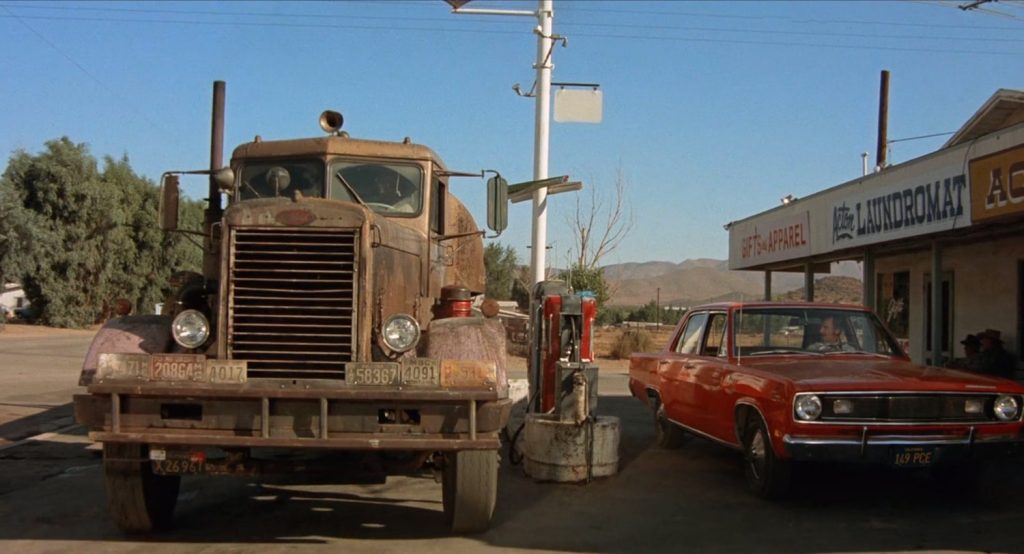 Always Trust Your Gas Station Attendant
Always Trust Your Gas Station Attendant
Thomas Parker is a native Southern Californian and a lifelong science fiction, fantasy, and mystery fan. When not corrupting the next generation as a fourth grade teacher, he collects Roger Corman movies, Silver Age comic books, Ace doubles, and despairing looks from his wife. His last article for us was A Metaphysical Nightmare: Brian Moore’s Cold Heaven
7 Author Shoutouts | Authors We Love To Recommend
Here are seven Author Shoutouts for this week. Fine one of your favorite authors or…
The post 7 Author Shoutouts | Authors We Love To Recommend appeared first on LitStack.
Vexing the Grumpy Orc - Book Review by Voodoo Bride
 Vexing the Grumpy Orc (Silvermist Mates #3)by Chloe Graves
Vexing the Grumpy Orc (Silvermist Mates #3)by Chloe GravesWhat is it about:Territory lines weren't made to keep out fate.
HannahSaving my petrified familiar requires rare mountain mushrooms and sacred ritual grounds. Unfortunately, both sit squarely in one extremely hot and incredibly grumpy orc's territory. One defiant step across my ritual circle unleashes magic far more dangerous than any gorgon's curse—the kind that burns between bodies instead of bones.
But with Digby's stone form growing colder by the day, failure isn't an option—even if success means trusting the orc who ruins my spells with a single touch.
GalanWitches destroy everything they touch. My father's exile taught me that lesson well.
But this witch stalks my woods with a sharp tongue and even sharper magic. Her fierce loyalty and forbidden rituals set my blood burning and instincts snarling for more.
My chief shatters my solitude and commands me to keep her safe while my father orders me to march her off a cliff. Blood should win over heart, but she makes me question every truth I thought I knew.
Fate branded Hannah into my soul, and I won't rest until I claim her as mine.
What did Voodoo Bride think of it:I have a soft spot for grumpy men (well, others think they're grumpy, but they're not grumpy to me) so I decided to give this book a try.
Maybe I should have started with the first book, where this world gets set up. Because I was convinced this was Other World Fantasy Romance. It even read that way at first. Then suddenly there was a mention of American states, and then jeans, and other modern stuff.
Turns out this is what I would call an Urban Fantasy Romance.
That really threw me. I mean: Orcs in Fantasy or SciFi/Cyberpunk settings are one thing, but it seems I never thought of Orcs belonging in Urban Fantasy. The Orc village feeling very Other World Fantasy didn't help in getting used to the otherwise modern setting.
But that weird disconnect aside:I really enjoyed the romance.
I didn't like Hannah at first. She really is annoying and a total jerk for someone caught trespassing, and I was just as grumpy about her as Galan (who I did like right away).But things get hot and steamy fast between them, and she does get less annoying luckily enough. From then on I was totally invested in the two of them figuring things out and getting in some more loving.
All in all a very enjoyable Romance and I might try other books in this series.
Why should you read it:Hot Grumpy Orc!
A Sword & Sorcery Series I Really Love: Flashing Swords!, edited by Lin Carter
Flashing Swords! #2, 4, & 5 (Science Fiction Book Club, September 1973, May 1977,
and December 1981). Covers by Frank Frazetta, Gary Viskupic, and Ron Miller
It’s time to take a look at another Sword & Sorcery anthology series I really love: Flashing Swords, edited by Lin Carter. It is second in my affections only to the Swords Against Darkness 5-book series edited by Andy Offutt that I wrote about here last year.
Flashing Swords! came out of the group known as SAGA, which stood for the Swordsmen and Sorcerers Guild of America, a group in the 1970s and 80s that included almost all the elite S&S writers of the age.
They were an informal group but Lin Carter was the closest thing they had to a leader. Under his editorship, five outstanding anthologies of works from their members appeared, all new stories, not reprints. As shown in the pictures below, I have the volumes from Dell paperbacks, as they were originally released, and three from Nelson Doubleday in hardback (above), as they were offered by the Science Fiction Book Club.
[Click the images for flash versions.]
Flashing Swords #1 (Dell, July 1973). Cover by Frank Frazetta
Flashing Swords #1 (1973) has 4 longish stories by Leiber, Vance, Anderson and Carter. All were strong and this is probably the strongest of all the volumes. Anderson’s story, “The Merman’s Children,” is the best, and Carter’s story, “The Higher Heresies of Oolimar,” is one of his strongest ever.
The cover was an awesome Frazetta, one of my favorites of his paintings behind his Kane and Death Dealer art. The volume was dedicated appropriately to Robert E. Howard.
Flashing Swords! #2 (Dell, April 1974). Cover by Frank Frazetta
Flashing Swords #2 (1973) is dedicated to Henry Kuttner. It had four more long stories, by L. Sprague de Camp (with whom Carter had a long history), Michael Moorcock, Andre Norton, and John Jakes.
Moorcock’s story, “The Jade Man’s Eyes,” was of Elric, and Jakes’ story, “Ghouls Garden,” was about his character Brak. I’ll talk more about both authors eventually here but both these tales were very good and I particularly loved the Brak story, which made me seek out more of the tales.
Flashing Swords #1 & 2, UK editions (Mayflower, 1974 and February 1975). Covers by Bruce Pennington
The hardback has a great Frazetta cover, but have a look, too, at the paperback cover from Mayflower books (above), which I found online. I like that one even better than the Frazetta I think, although that sounds almost blasphemous.
Bruce Pennington did it and I wish I had that edition.
Flashing Swords! #3: Wizards and Warriors (Dell, August 1976). Cover by Don Maitz
Flashing Swords #3 (1976) bore a subtitle, Warriors and Wizards. It was dedicated to Clifford Ball. This was the weakest of the five volumes, although still good. It had stories by de Camp, Fritz Leiber, Andre Norton, Carter, and Avram Davidson.
The Leiber story, “The Frost Montreme” — Fafhrd and the Gray Mouser — was the strongest. Don Maitz is the cover artist. It’s good, but a bit less barbaric than I like. Very Renaissance looking.
Flashing Swords! #4: Barbarians and Black Magicians (Dell, November 1977). Cover by Don Maitz
Flashing Swords #4 (1977) is subtitled Barbarians and Black Magicians. This one is dedicated to Norvell Page, who I’ll be covering here. Stories by Vance, Anderson, Jakes (Brak; Storm in a Bottle), Katherine Kurtz, and Moorcock (Elric; “the Lands Beyond the World”).
This one is as strong as the original volume, and I like the hardback cover by Gary Viskupik. It also has some cool interior illos by Rick Bryant. The paperback cover, which I found online, is by Don Maitz again and looks like an Elric representation.
Flashing Swords! #5: Demons and Daggers (Dell, December 1981). Cover by Rich Corben
Flashing Swords #5 (1981) is subtitled Demons and Daggers. No dedication. It has a cool wraparound cover by Ron Miller, although it’s my least favorite of the series. The Dell paperback has a cover by Richard Corben.
Includes stories by Roger Zelazny (a Dilvish tale), C. J. Cherryh, Diane Duane, Tanith Lee, and the first humorous story in the series by Craig Shaw Gardner. I didn’t think it was as strong as #1, #2, or #4, but somewhat better than #3.
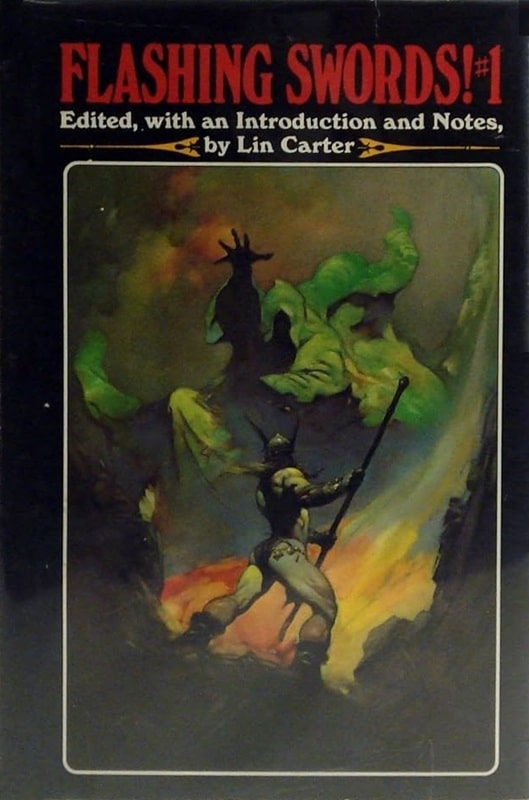
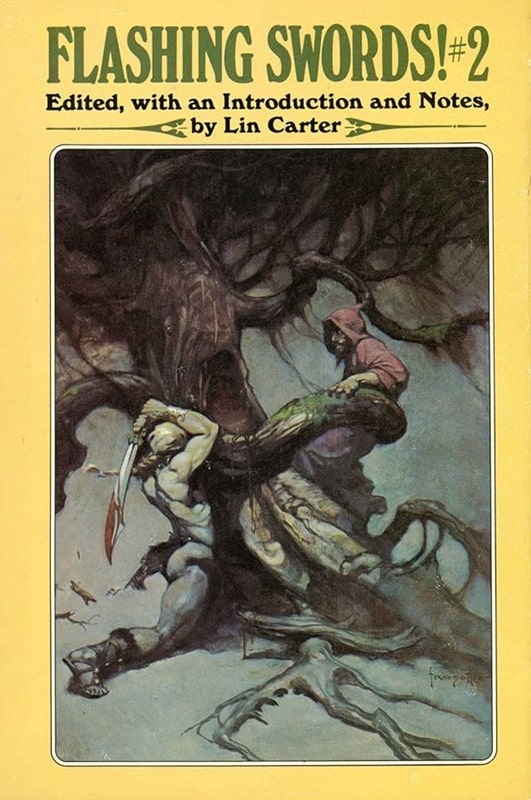
Flashing Swords! #1 & 2 (Science Fiction Book Club, April and September 1973). Covers by Frank Frazetta
In 2020, Robert Price, Lin Carter’s literary executor, revived the series as Lin Carter’s Flashing Swords. There have been two volumes published, although the first one created a minor storm of controversy over the introduction by Price. I have not yet bought or read these two volumes.
I’ve also included above the hardcover covers for volumes 1 and 2 (above), both by Frazetta.
Charles Gramlich administers The Swords & Planet League group on Facebook, where this post first appeared. His last article for Black Gate was Sword & Sorcery on a Post-Apocalyptic Earth: Blackmark by Gil Kane.
Women in SF&F Month: J. D. Evans
Today’s Women in SF&F Month guest is J. D. Evans! She is the author of the epic fantasy romance series Mages of the Wheel, which currently contains five novels. Reign & Ruin, her debut novel and the Self-Published Fantasy Blog-Off Award–winning first book in her series, features a Sultana and prince who “must find a way to save their people from annihilation and balance the sacred Wheel.” I’m thrilled she’s here today with her essay “In Defense of the Kind […]
The post Women in SF&F Month: J. D. Evans first appeared on Fantasy Cafe.Teaser Tuesdays - Under the Surface

Selena peers into the hole, then jerks back. "Whoa, that goes really far down."
Julien waves us closer. "We must hurry, yes?"
(page 33, Under the Surface by Diana Urban)
---------
Teaser Tuesdays is a weekly bookish meme, previously hosted by MizB of Should Be Reading. Anyone can play along! Just do the following: - Grab your current read - Open to a random page - Share two (2) “teaser” sentences from somewhere on that page BE CAREFUL NOT TO INCLUDE SPOILERS! (make sure that what you share doesn’t give too much away! You don’t want to ruin the book for others!) - Share the title & author, too, so that other TT participants can add the book to their TBR Lists if they like your teasers!
Book review: Where The Axe is Buried by Ray Nayler

Book links: Amazon, Goodreads
ABOUT THE AUTHOR: Ray Nayler is the author of the Locus Award winning novel The Mountain in the Sea. For nearly half his life, Ray has lived and worked outside the United States in the Foreign Service, the Peace Corps, and in international development. He was Environment, Science, Technology, and Health Officer at the U.S. consulate in Ho Chi Minh City. He most recently served as international advisor to the Office of National Marine Sanctuaries at the National Oceanic and Atmospheric Administration, and as a diplomatic fellow and visiting scholar at the George Washington University's Institute for International Science and Technology Policy. He lives in Washington, DC.
Publisher: MCD (April 1, 2025) Length: 336 pages Formats: audiobook, ebook, paperback
Nayler’s previous works impressed me. They are quieter, more cerebral, and heavier than most sci-fi I see nowadays. Where the Axe is Buried is no exception - it’s ambitious, sometimes dense, often cerebral, and very much not here to hold your hand.
Zoya, a revolutionary leader, is living on borrowed time. Lilia, a scientist, is quietly lighting a match under a corrupt regime. Both feel their world is falling apart in slow motion. Resistance movements aged into institutions, rebellion calcified into bureaucracy, and some people became symbols at the expense of their humanity. Surveillance became part of daily life, social credit systems force social obedience. Huh. Actually, it doesn’t feel like a far-off dystopia.
The story here is complex and drops readers into a tangled web of politics, ideologies, and slippery truths. There were definitely moments where I had to pause, re-read, or just pause. It’s dense, and not every reader is going to vibe with that. Especially if you come to sci-fi for character-driven stories -because while the characters here are interesting, they’re not always warm or even likable.
There’s a lot of high-concept tech in here (consciousness transfer, AI-run governments, memory networks), which is cool and disturbing. What happens when history is controlled by algorithms? Who decides what the future looks like? Can power ever truly be neutral? And so on, and so on, with no simple answers.
Overall, I felt Where The Axe is Buried is more interested in systems than individuals, in ideology over intimacy. It’s intellectually rich, occasionally chilly, but worth the effort.
Book Review: Another Fine Mess by Lindy Ryan
I received a review copy from the publisher. This does not affect the contents of my review and all opinions are my own.
 Another Fine Mess by Lindy Ryan
Another Fine Mess by Lindy Ryan
Mogsy’s Rating: 4 of 5 stars
Genre: Horror
Series: Book 2 of Bless Your Heart
Publisher: Minotaur Books (April 15, 2025)
Length: 368 pages
Author Information: Website | Twitter
I think once you get a feel for what the Bless Your Heart series is all about, it’s easy to fall in love with it. From the cover and synopsis vibes, you’d be right to guess this isn’t the kind of horror that keeps you up at night, but neither is it your typical fluffy, quirky cozy mystery. In fact, it hits that sweet spot somewhere in between—a little bit dark, a little bit weird, with just enough humor to keep things fun and the unsettling moments from taking over. Another Fine Mess is the second book in the series, and it continues to build on this balance.
Picking up not long after the events of Bless Your Heart, this sequel drops us back into the small southeastern Texas town where the women of the Evans family have spent generations keeping the peace in a very unexpected way. For you see, the dead have a way of not staying dead here, but running the local funeral home means the Evanses are the first line of defense whenever the deceased gets restless. Following the devastating losses from the end of the first book though, only Lenore Evans and her teenage granddaughter Luna are left to hold down the fort. Now they are desperate for some answers, and the new sheriff in town is way out of his depth and not much help. Only family secrets, half-forgotten lore, and the remnants of old legends can help them figure out what’s happening to their town.
Lately, there’s been a string of unexplained occurrences—locals vanishing without a trace, mysterious deaths, and an uptick in missing pets. While most folks in town are quick to blame it on a rabid animal on the loose, Lenore knows better. She recognizes the signs of a strigoi attack all too well. These are troubled spirits fueled with relentless rage, and they won’t stop until they’re put down for good. In the meantime though, the Evans women must keep the townsfolk calm, hiring some extra help at the funeral home to disguise the gory nature of the deaths. However, authorities have also hired a wolf expert from the university to investigate, and she’s skeptical that the killings have anything to do with an animal. As the body count rises, causing the media to descend upon the town, Lenore and Luna must race against time to find a solution before whatever is out there comes for them next.
In this worthy follow-up, the author keeps the plot brisk and engaging, layering scenes of bloody horror with easy humor and endearing character relationships. It’d definitely be helpful if you’ve read the first book, as many of these dynamics have been carried forward from Bless Your Heart. The story unfolds through multiple points of view, mostly from key players like Lenore and Luna, but there are some supporting POVs thrown in throughout for extra flavor. In addition, there is even a major character whose presence in this sequel surprised me, but it was also very welcome.
Of course, what I enjoyed most about this book was the way it embraced both the horror ingredients as well as the light-hearted elements found in any story about complex family ties. Underneath all the blood splatter of disembowelments and dismembered limbs is a solid core based around a family’s shared grief, resilience, and love. Not even death can break the bonds between the Evans women, and the relationships between them show that what they mean to each other transcends generations and even traditional mortal boundaries. In the horror department, what we get here leans more towards gore and the macabre, but a lot of it is done in such an over-the-top way that it doesn’t end up all that scary. In fact, the campiness was actually kind of refreshing, and Ryan’s version of the vampire and werewolf mythos feels both familiar and inventive when combined with the charming properties of Southern Gothic tropes.
Overall, Another Fine Mess is a fast and witty sequel, and together with its predecessor makes for an entertaining and unique entry in the urban fantasy horror genre. With the second book, considered me sold on the quirky family drama and gallows humor of this series. I would love to see the Evans women return for more stories in this darkly charming Southern setting, and if that happens, I’ll definitely be back.
![]()
![]()
Women in SF&F Month: A. G. Slatter
This week of Women in SF&F Month starts with an essay by A. G. Slatter! Her work includes The Bitterwood Bible and Other Recountings (winner of the World Fantasy Award for Best Collection), Of Sorrow and Such (winner of the Ditmar Award for Best Novella), and The Path of Thorns (winner of the Aurealis and Australian Shadows Awards for Best Fantasy Novel). Her most recent novel, the gothic fantasy The Crimson Road, is described as “a tale of vampires, assassins, ancient […]
The post Women in SF&F Month: A. G. Slatter first appeared on Fantasy Cafe.Spotlight on “The Art Spy” by Michelle Young
The Art Spy, a riveting and stylish saga, uncovers how an unlikely heroine infiltrated the…
The post Spotlight on “The Art Spy” by Michelle Young appeared first on LitStack.
Windy City Pulp & Paper 2025 – ‘If Bob Were Here…’
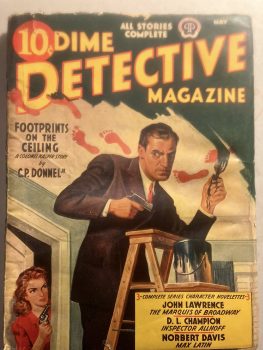
 It’s an early A (Black) Gat in the Hand, as I got my Pulp on week before last, at Windy City, in Chicago.
It’s an early A (Black) Gat in the Hand, as I got my Pulp on week before last, at Windy City, in Chicago.
I managed to resist the impulse to grab the microphone in the Dealers Room and proclaim, “Finally….The Bob…has come back…to Windy City.” A little classic Rock for you there. And in not doing so, I wasn’t evicted and had a great time.
Doug Ellis puts on the Windy City Pulp and Paper Convention annually at the Lombard Westin, in the suburb an hour west of Chicago. I last attended in 2019. Of course, COVID hit in 2020, along with some other life changes. I made it to my first Howard Days in 2022, and headed over to Pittsburgh the last two years for Pulp Fest. Windy City just didn’t quite happen. But I made sure it did in 2025.
There’s an auction, some panels, an art show, and a massive Dealer Room. I’ll share my purchases here in a minute. But hands down, the best part of Windy City for me, is hanging and chatting with people. I see lots of online friends and some folks I’ve met before. I even make new friends. Sort of.
Walking around the Dealer Room and getting into conversations on pulp or paperback favorites is a blast. I find somebody to chat Nero Wolfe, or Jo Gar, or Solar Pons, or Solomon Kane, or Bail Bond Dodd, or…you get the idea. I found myself showing my Civil War shelfie to someone, as they talked about Shelby Foote.
There are always folks sitting around the lobby. I’ve met new friends just sitting down and working into the conversation. Saturday night, Ryan Harvey, Chris Hocking, James Enge, and I, spent over two hours just riffing through movies and writers. Ryan’s knowledge of multiple movie genres is staggering. And what those three knew about movie soundtracks left me soaking it in.
Add in eating a couple meals with friends, and the social aspect of Windy City is hands down my favorite part. As you’ll see, I find things to buy – and I restrain myself every year – but it’s talking about mutual interests at Windy City that is the highlight for me. Glad I made it back. See you there in 2026? Between the ever-present LA Dodgers cab, and a shirt with ‘Byrne’s Pub’ writ large on the back, I’m easy to spot.
What Did I Buy?
Max Latin!You may (or may not) know, I wrote the introduction to Steeger Books’ reissue of the collected Max Latin short stories. Norbert Davis is on my Hardboiled Mt. Rushmore, and the shady private eye Latin, is my favorite work of his. The fact that my intro replaced the last professional piece written by my favorite writer, John D. MacDonald, is awesome. You can read my intro, here at Black Gate.
For $70, I got the May 1942 issue of Dime Detective, containing “Give the Devil His Due.” This was the fifth Latin story, and I am now the proud owner of an original Latin story. There’s also a Marquis of Broadway by John Lawrence in this issue.
Gotta Have Some Howard! Will Oliver on the left. I think Security was trying to find the guy on the right, most of the show. Wait, that’s John Bullard. I stand by what I said…
Will Oliver on the left. I think Security was trying to find the guy on the right, most of the show. Wait, that’s John Bullard. I stand by what I said…
I resisted the impulse to bring home a haul of Robert E. Howard-related books. It’s easy to find more cool stuff to add to my library – even if I already have the stories included. But Robert E. Howard Foundation folks. Bill Cavalier, Paul Herman, and John Bullard were there. And breakfast with John and Paul was a conversational potpourri I won’t soon forget!
Held every June in REH’s hometown of Cross Plain, TX, Howard Days is a terrific gathering of Howard fans from all over the world. I wish I’d been into Howard back when I lived in Austin. Highly recommended weekend.
I met Will Oliver, a really cool guy (when you’re as cool as I am, you are drawn to other cool people. Yeah…) when I was down there. Will just put out an extensively referenced, door-stopper of a biography of Howard. I grabbed a copy directly from Will at the table, which he kindly signed. I am looking forward to digging into this and probably talking about it during this summer’s run of A (Black) Gat in the Hand.
Cool & LamI’ve written about my favorite Erle Stanley Gardner series many times here at Black Gate. But it’s not Perry Mason. I like the do-it-all lawyer, but the mismatched duo of Bertha Cool and Donald Lam easily hold my ESG top spot. You can find all of my Cool and Lam posts here, including the ‘lost’ pilot, with an intro by Gardner himself.
I don’t have quite all the books, and many are falling apart. As in, I’ve had to toss a couple. Those old Dell paperbacks get extremely brittle. I was happy to pick up two replacement copies at just $5 each. If you haven’t read Cool and Lam, you’re missing out on some high quality PI fiction. At least check out my first post on them, which is based on essay I wrote for Black Mask magazine (yeah, I appeared in THE Black Mask!).
The Frederick Nebel Library Grows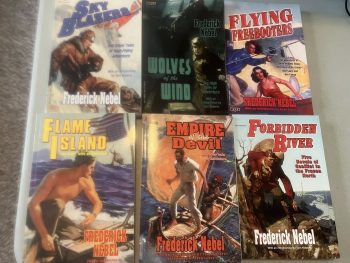 So, Norbert Davis’s is the third face on my Hardboiled Mt. Rushmore. Frederick Nebel is number two. Nebel was the guy that Joe ‘Cap’ Shaw tapped to slide into Dashiell Hammett’s place when the latter left Black Mask (and the Pulps). My library has a lot of Nebel from Steeger Books, including Cardigan, MacBride and Kennedy, and the under-appreciated Gales & McGill.
So, Norbert Davis’s is the third face on my Hardboiled Mt. Rushmore. Frederick Nebel is number two. Nebel was the guy that Joe ‘Cap’ Shaw tapped to slide into Dashiell Hammett’s place when the latter left Black Mask (and the Pulps). My library has a lot of Nebel from Steeger Books, including Cardigan, MacBride and Kennedy, and the under-appreciated Gales & McGill.
I already had a couple of Nebel’s air adventures from Illinois’ Black Dog Books. But when I saw Tom Roberts with a table at Windy City, I couldn’t resist. I picked up Sky Blazers, plus the three books along the bottom. Also, three more non-Nebels. I have a couple other digital books from Black Dog. Tom is putting out terrific Pulp by a lot of authors who deserve to still be read. And he has some great intros (I’m still trying to con him… I mean, convince him, to let me write one). I’m a fan of Black Dog, and you should check them out.
Sky Blazers/Wolves of the Wind/Flying Freebooters
I’m not into the Air Pulp genre – in fact, I can’t really even discuss it knowledgeably (like THAT ever stops me, as you well know). But I really enjoy Nebel’s Gales & McGill series, just about all of which appeared in Air Stories, I believe.
I now own all six Nebel books from Black Dog. The top three are all air stories, a few with recurring characters. Nebel and Horace McCoy are the only Air Pulps writers I read, and I’m looking forward to more Nebel.
Flame Island and Empire of the Devil are short story collections of exotic tales from the Adventure Pulps. This is another genre I haven’t read much, but with over 600 pages of Nebel, I’ll be working my way through these. Two of the stories were made into films.
Forbidden River – Nebel started out writing Canadian adventures – you know, Mounties and trappers. Forbidden River contains five such stories. Steeger has also put out two collections of these. Nebel was writing Northern adventures when he joined Black Mask.
Roger TorreyI have the excellent short story collection, Bodyguard, in digital. I couldn’t pass up a second Torrey book: this time in print. Torrey wrote in a straight hardboiled style, and he didn’t change at all as the genre moved more towards the Cornell Woolrich or John D. MacDonald style of mysteries. He was also a major alcoholic and became unreliable and of quite variable quality. He died young, still writing for the ‘lesser’ pulps. But when he was good, he was very good, and I’m a Torrey fan.
Norvell Page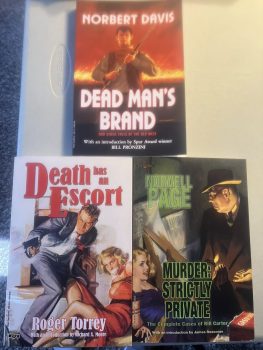 Page is best known as the primary writer of the hero Pulp, The Spider (under the house name, Grant Stockbridge). Like most Pulpsters, he wrote many genres, including weird menace, and G-men stories. I have his limited Western output as a Black Dog e-book.
Page is best known as the primary writer of the hero Pulp, The Spider (under the house name, Grant Stockbridge). Like most Pulpsters, he wrote many genres, including weird menace, and G-men stories. I have his limited Western output as a Black Dog e-book.
I really struggle with the Spicy Pulps. Briefly a popular genre, they’re just so goofy I can’t take them seriously enough to enjoy them. I wrote a post on a Robert E. Howard spicy story – and it was more of a saucy-tinged adventure. Whereas, I can’t even finish a Dan Turner (Hollywood Detective) story
in one -sitting.
Robert Leslie Bellem’s Turner is the most popular of the spicy detectives, even getting his own magazine. But to me, it’s like a parody of Race Williams. And Williams can be hard enough to absorb, without making it a spicy parody.
Page wrote a series of spicy stories featuring Bill Carter (who is not his Weird Menace star, Ken Carter), an investigative reporter in Miami. This volume collects (all?) twenty of them. Page is still kinda over-the-top for me, but these are FAR more readable than the Dan Turner stories. I’ll work my way through this book.
Norbert Davis’ WesternsI already had this in digital, but I couldn’t pass up the print edition. Davis didn’t write many Westerns, but he wrote some damn good ones. I already did this Black Gate post on one of my favorites, “A Gunsmoke Case for Major Cain.” I plan on covering a couple more for the summer Pulp series along the way. I really like his Westerns.
MISCI also picked up a Dell Mapback of Rex Stout’s Tecumseh Fox mystery, Double for Death. I like Mapbacks, and try to pick up one or two when they aren’t too expensive. I got a few Stouts last year at Pulp Fest.
Also, you should definitely attend Windy City next year if you want to play ‘If Bob Were Here.’ To hear something I said repeated back conversationally with “If Bob were here, I bet he would say…” I’m used to being ragged on. To combine it with being ignored is really impressive!
The Art Room
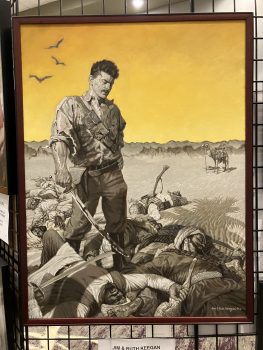
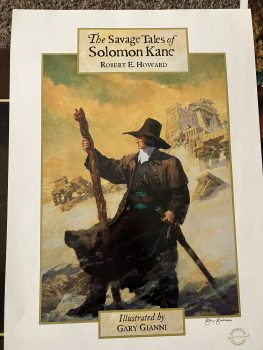 I snapped a few pics of the really cool stuff in the Art Show, but I wish I had been dialed in for it. I would have gotten a lot. The Mark Wheatley, and Gary Gianni stuff, had most of my attention. But there was some neat REH and Edger Rice Burroughs stuff too.
I snapped a few pics of the really cool stuff in the Art Show, but I wish I had been dialed in for it. I would have gotten a lot. The Mark Wheatley, and Gary Gianni stuff, had most of my attention. But there was some neat REH and Edger Rice Burroughs stuff too.
I like this El Borak print by Jim and Ruth Keegan, from the Wandering Star/Del Rey books. There was a cool Solomon Kane pic by Gianni. There was a statue in front of it which it mirrors. I wish I’d taken a close up of it. I will be more focused when I visit the Art Room next time.
Gary Gianni was selling five prints for $30 – signed, at a table. I snagged them! There were four Solomon Kanes – color, and black and white. Also, one larger sized Conan from “A Witch Shall Be Born.”
He chatted with folks and is a super nice guy. I’m friends with Bill Cavalier (well, I don’t think he refutes that statement, anyways) and have met Mark Wheatley and Mark Schulz at Pulp Fest. Robert E. Howard artists have been really nice folks.
THE HOWARD ANDREW JONES PANEL
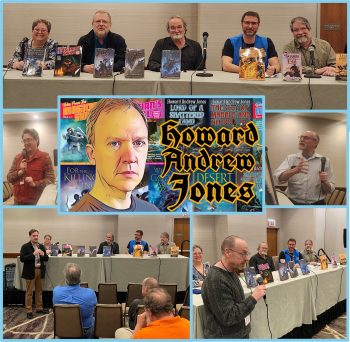 A lot of Howard’s friends and fans were at Windy City. There was a panel to remember and celebrate Howard, curated by his biggest fan and supporter, Arin Komins. John O’Neill, James Enge, Seth Lindberg, and John Hocking shared thoughts and memories. Audience members were also offered the opportunity to speak, and Howard’s fellow Black Gaters Ryan Harvey, Greg Mele, and myself, spoke fondly of our missed friend.
A lot of Howard’s friends and fans were at Windy City. There was a panel to remember and celebrate Howard, curated by his biggest fan and supporter, Arin Komins. John O’Neill, James Enge, Seth Lindberg, and John Hocking shared thoughts and memories. Audience members were also offered the opportunity to speak, and Howard’s fellow Black Gaters Ryan Harvey, Greg Mele, and myself, spoke fondly of our missed friend.
Kudos to Doug Ellis for setting aside time for Howard to be front and center. Mentions of him were peppered throughout the weekend among the Black Gate and associated crowd. We will be fondly remembering him for a long time to come.
One audience member came up and talked about helping when Howard was putting together the Harold Lamb collections. And he revealed there were some Lamb stories (four, maybe?) that they didn’t have the rights to, and I think Howard had edited those as well. Would be need to see those added to Howard’s Lamb work.
Jason Waltz – you can believe I took Arin and company to task as they were setting up the books, and there was no Hither Came Conan!
Prior Posts in A (Black) Gat in the Hand
2025 (1)
2024 Series (11)
Will Murray on Dashiell Hammett’s Elusive Glass Key
Ya Gotta Ask – Reprise
Rex Stout’s “The Mother of Invention”
Dime Detective, August, 1941
John D. MacDonald’s “Ring Around the Readhead”
Harboiled Manila – Raoul Whitfield’s Jo Gar
7 Upcoming A (Black) Gat in the Hand Attractions
Paul Cain’s Fast One (my intro)
Dashiell Hammett – The Girl with the Silver Eyes (my intro)
Richard Demming’s Manville Moon
More Thrilling Adventures from REH
Prior Posts in A (Black) Gat in the Hand – 2023 Series (15)
Back Down those Mean Streets in 2023
Will Murray on Hammett Didn’t Write “The Diamond Wager”
Dashiell Hammett – ZigZags of Treachery (my intro)
Ten Pulp Things I Think I Think
Evan Lewis on Cleve Adams
T,T, Flynn’s Mike & Trixie (The ‘Lost Intro’)
John Bullard on REH’s Rough and Ready Clowns of the West – Part I (Breckenridge Elkins)
John Bullard on REH’s Rough and Ready Clowns of the West – Part II
William Patrick Murray on Supernatural Westerns, and Crossing Genres
Erle Stanley Gardner’s ‘Getting Away With Murder (And ‘A Black (Gat)’ turns 100!)
James Reasoner on Robert E. Howard’s Trail Towns of the old West
Frank Schildiner on Solomon Kane
Paul Bishop on The Fists of Robert E. Howard
John Lawrence’s Cass Blue
 Dave Hardy on REH’s El Borak
Dave Hardy on REH’s El Borak
Prior posts in A (Black) Gat in the Hand – 2022 Series (16)
Asimov – Sci Fi Meets the Police Procedural
The Adventures of Christopher London
Weird Menace from Robert E. Howard
Spicy Adventures from Robert E. Howard
Thrilling Adventures from Robert E. Howard
Norbert Davis’ “The Gin Monkey”
Tracer Bullet
Shovel’s Painful Predicament
Back Porch Pulp #1
Wally Conger on ‘The Hollywood Troubleshooter Saga’
Arsenic and Old Lace
David Dodge
Glen Cook’s Garrett, PI
John Leslie’s Key West Private Eye
Back Porch Pulp #2
Norbert Davis’ Max Latin
Prior posts in A (Black) Gat in the Hand – 2021 Series (7 )
The Forgotten Black Masker – Norbert Davis
Appaloosa
A (Black) Gat in the Hand is Back!
Black Mask – March, 1932
Three Gun Terry Mack & Carroll John Daly
Bounty Hunters & Bail Bondsmen
Norbert Davis in Black Mask – Volume 1
Prior posts in A (Black) Gat in the Hand – 2020 Series (21)
Hardboiled May on TCM
Some Hardboiled streaming options
Johnny O’Clock (Dick Powell)
Hardboiled June on TCM
Bullets or Ballots (Humphrey Bogart)
Phililp Marlowe – Private Eye (Powers Boothe)
Cool and Lam
All Through the Night (Bogart)
Dick Powell as Yours Truly, Johnny Dollar
Hardboiled July on TCM
YTJD – The Emily Braddock Matter (John Lund)
Richard Diamond – The Betty Moran Case (Dick Powell)
Bold Venture (Bogart & Bacall)
Hardboiled August on TCM
Norbert Davis – ‘Have one on the House’
with Steven H Silver: C.M. Kornbluth’s Pulp
Norbert Davis – ‘Don’t You Cry for Me’
Talking About Philip Marlowe
Steven H Silver Asks you to Name This Movie
Cajun Hardboiled – Dave Robicheaux
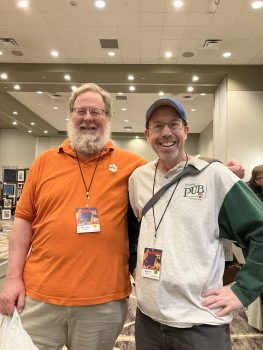 More Cool & Lam from Hard Case Crime
More Cool & Lam from Hard Case Crime
A (Black) Gat in the Hand – 2019 Series (15)
Back Deck Pulp Returns
A (Black) Gat in the Hand Returns
Will Murray on Doc Savage
Hugh B. Cave’s Peter Kane
Paul Bishop on Lance Spearman
A Man Called Spade
Hard Boiled Holmes
Duane Spurlock on T.T. Flynn
Andrew Salmon on Montreal Noir
Frank Schildiner on The Bad Guys of Pulp
Steve Scott on John D. MacDonald’s ‘Park Falkner’
William Patrick Murray on The Spider
John D. MacDonald & Mickey Spillane
Norbert Davis goes West(ern)
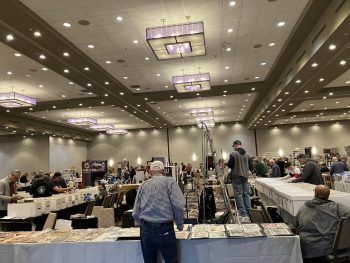 Bill Crider on The Brass Cupcake
Bill Crider on The Brass Cupcake
A (Black) Gat in the Hand – 2018 Series (32)
George Harmon Coxe
Raoul Whitfield
Some Hard Boiled Anthologies
Frederick Nebel’s Donahue
Thomas Walsh
Black Mask – January, 1935
Norbert Davis’ Ben Shaley
D.L. Champion’s Rex Sackler
Dime Detective – August, 1939
Back Deck Pulp #1
W.T. Ballard’s Bill Lennox
Erle Stanley Gardner’s The Phantom Crook (Ed Jenkins)
Day Keene
Black Mask – October, 1933
Back Deck Pulp #2
Black Mask – Spring, 2017
Erle Stanley Gardner’s ‘The Shrieking Skeleton’
Frank Schildiner’s ‘Max Allen Collins & The Hard Boiled Hero’
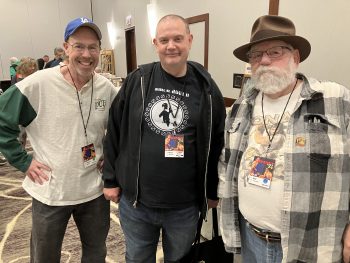 A (Black) Gat in the Hand: William Campbell Gault
A (Black) Gat in the Hand: William Campbell Gault
A (Black) Gat in the Hand: More Cool & Lam From Hard Case Crime
MORE Cool & Lam!!!!
Thomas Parker’s ‘They Shoot Horses, Don’t They?’
Joe Bonadonna’s ‘Hardboiled Film Noir’ (Part One)
Joe Bonadonna’s ‘Hardboiled Film Noir’ (Part Two)
William Patrick Maynard’s ‘The Yellow Peril’
Andrew P Salmon’s ‘Frederick C. Davis’
Rory Gallagher’s ‘Continental Op’
Back Deck Pulp #3
Back Deck Pulp #4
Back Deck Pulp #5
Joe ‘Cap’ Shaw on Writing
Back Deck Pulp #6
The Black Mask Dinner

Bob Byrne’s ‘A (Black) Gat in the Hand’ made its Black Gate debut in 2018 and has returned every summer since.
His ‘The Public Life of Sherlock Holmes’ column ran every Monday morning at Black Gate from March, 2014 through March, 2017. And he irregularly posts on Rex Stout’s gargantuan detective in ‘Nero Wolfe’s Brownstone.’ He is a member of the Praed Street Irregulars, founded www.SolarPons.com (the only website dedicated to the ‘Sherlock Holmes of Praed Street’).
He organized Black Gate’s award-nominated ‘Discovering Robert E. Howard’ series, as well as the award-winning ‘Hither Came Conan’ series. Which is now part of THE Definitive guide to Conan. He also organized 2023’s ‘Talking Tolkien.’
He has contributed stories to The MX Book of New Sherlock Holmes Stories — Parts III, IV, V, VI, XXI, and XXXIII.
He has written introductions for Steeger Books, and appeared in several magazines, including Black Mask, Sherlock Holmes Mystery Magazine, The Strand Magazine, and Sherlock Magazine.
You can definitely ‘experience the Bobness’ at Jason Waltz’s ’24? in 42′ podcast.
Review: A Drop of Corruption by Robert Jackson Bennett (Reviewed by Caitlin)

Buy A Drop of Corruption
Read a review of Book One, The Tainted Cup
Read Lukasz's review of A Drop of Corruption
OVERVIEW/ANALYSIS: Investigators Ana and Dinios are used to unusual crimes, so investigating the disappearance of a Treasury officer from a locked room is a relatively trivial matter. It's only a matter of hours before Ana not only works out how the person disappeared, but also deduces that they have been murdered as well. But as to who did it and why? That's a much trickier mystery to solve. The culprit seems to possess an almost supernatural ability to circumvent security measures and to anticipate Ana's investigation. The only thing Ana knows for sure is that the murderer's ultimate target is the Shroud, a high-security factory where the Empire harvests the leviathan blood that drives so much of it. And if the Shroud falls, the Empire could fall with it.
A Drop of Corruption is another rousing success from Robert Jackson Bennett, at once both a twisty mystery and harsh critique of colonialism. Returning fans will settle right back in with Ana and Din's familiar cadence: Din does the leg-work, interviewing witnesses and assessing crime scenes, while Ana takes the information and works out how the pieces come together. I was glad to see how Din had grown into his role, understanding that Ana's sometimes odd requests always have a reason, and knowing what kinds of information Ana is looking for.
Even though Ana and Din are working on behalf of the Empire, this is not a book that takes the side of the Empire. Instead, it uses the mystery to examine the messy can of worms that comes from colonizing an already inhabited land. While many of those Din interviews are high level officials, there is attention paid to the common folk who get caught in the middle of the political games between the Empire and the native regional government. The story also acknowledges that there are no clean solutions to the problem, as the Empire pulling out of the colony comes with its own set of headaches and injustices.
This book never feels like a lecture, however, because the message is blended with the absolutely engrossing world-building. A Drop of Corruption continues to iterate on the weird alchemical enhancements introduced in the first book, introducing us to new weird ways people alter themselves in this world. And in the process of delving deeper into the science of alchemy...well let's say some past things that may have registered as off to some readers may start to make sense.
CONCLUSION: In short, A Drop of Corruption further solidifies Robert Jackson Bennett as an autobuy author for me. From his deep, intricate world-building to his real world commentary, every one of his books is a full meal. Even if you're just here for the mystery, you're going to have a great time. But for those who just want to lose themselves in a completely different world? You need to pick his books up.
Neverwhens: War “On Earth, As it Is in Heaven” — Rebecca Roanhorse’s Mirrored Heavens
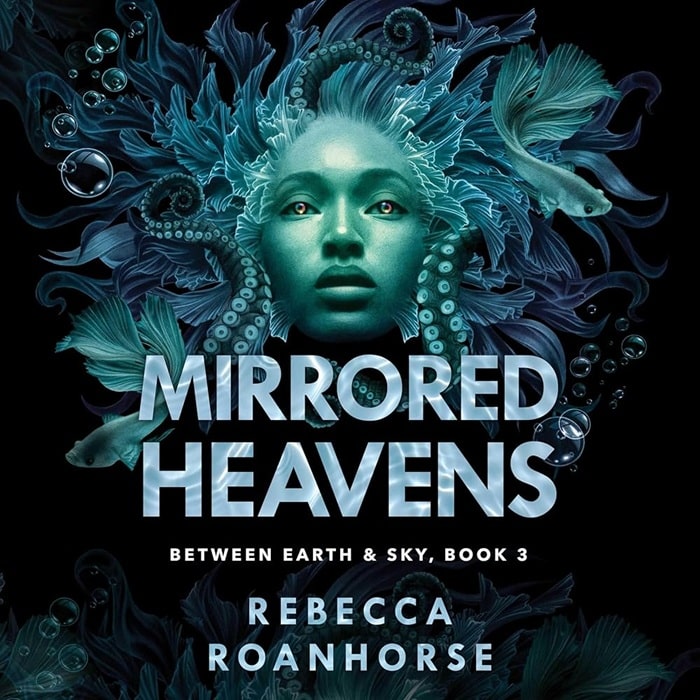 Mirrored Heavens by Rebecca Roanhorse (Saga Press, June 4, 2024)
Mirrored Heavens by Rebecca Roanhorse (Saga Press, June 4, 2024)
Between Earth & Sky has always been about doing something fresh.
Rebecca Roanhorse set out to create an epic fantasy set in a world based on the pre-contact Americas. It has its Maya, Cahokia, Ancestral Puebloan and Woodlands analog cultures; it has a seafaring matriarchy that is a bit Polynesian, a bit Caribbean, a bit “this would be cool.” But the world of The Meridian is its own thing. At times the technology is greater than what existed in our world, it has giant crows, eagles, insects and winged serpents tamed as mounts and its gods are very real, and not particularly benevolent.
But if the world the author sets her fantasy is drawing from cultures underused in fantasy, the story-structure is unique as well. This is not a story of a rising dark lord and the plucky heroes that rise against him. Its villains are all-too-human, motivate by sometimes petty desires, sometimes misplaced love, and if there is a “Dark Lord”, well he is one of the most sympathetic characters in the entire tale.
None of this is inversion for inversion’s sake; it is about telling a compelling, fresh story that feels authentic to the sources that inspired its author, and now it has all come to an end with Mirrored Heavens.
Sticking a landing is always tricky and Roanhorse to some extent set herself a challenging task at the end of Book 2. The mid-book of a trilogy is always a bridge story of revelations and few resolutions, but in Fevered Star we only truly see into the villain’s mind — or even realize his full roll — in the last third of the book. Our two main pairs of heroes: Serapio and Xiala, Narampa and Ixtan, spend the novel separated while the fifth main hero, Okoa, is mostly haplessly dragged from bad decision to bad decision. Things end with the predictable “it’s even worse now”, but other than an epic, beautifully rendered clash between Serapio and Narampa, as respective avatars of the Crow and Sun, in some ways the stage feels unset for resolution in one volume.
That would all be true if Roanhorse was trying to write The Lords of the Rings, pre-Contact Americas style. But she isn’t, and her story isn’t triggered by plot, but by characters. If there is a reveal in Fevered Star it is that all of our main characters, even the villainous Balam, have been motivated by personal relationships, disappointments or love. For all the interplay of ancient gods and prophecies, the story is indeed about Serapio and Xiala, Narampa and Ixtan, Okoa and yes, even evil Balam. It’s about family and isolation, a desire to belong and be loved, or what happens when that instead turns into possessive control. Consequently, to borrow a line from the otherwise wretched The Last Jedi: This isn’t going to go how you think it will.
Reading the above, one might think this is a very literary, slow book. It is not. From the first page there is assassination attempts, blood magic, scary monsters and marching armies. As with the first two volumes, Roanhorse’s prose is tight, sometimes even clipped, and her pages fly by. The summary of our situation: Serapio, now the Carrion King and ruler of Tova, is trying to cement his rule as the Crow clan’s living messiah, and knows that besides the other clans wishing to murder him, the rulership of his own clan has no love for being supplanted by living avatar.
All the other cities of the confederacy are marshalling against him, and he doesn’t even know that the villain behind it all is the man who sent him on his quest — and has been involved in his very creation from the start. He is presented with a prophecy, supposedly from the maw of the trickster god Coyote himself that says that if he slays his “unloved bride” and his father, he can win the three different wars brewing against him, but only by losing everything. What the hell does that mean, and how much further into dark, even cruel, paths will Serapio descend to fulfill it. Indeed — is he even the “good guy” and what is he trying to win?
Okoa, as brother to the Carrion Crow matron, has come to respect and idolize Serapio, but like everyone — fears him. His sister reveals the other clan matrons have learned of a weapon that can slay the Carrion King and demands Okoa’s help.
Narampa feels the power of the Sun growing in her and has fled to the north, to the Graveyard of the Gods — where it is said the gods made war and were “slain”/banished from the mortal world — seeking a shaman who can teach her how to use the mysterious godflesh mushrooms that will allow her to enter the various spirit worlds and fight to liberate her city from the Crow. Only she, too, does not realize Serapio is not the problem…
Ixtan is in the city of Hokaia, adrift and unsure what their path now is, until they learn that Narampa lives and that the southern lord Balam is at the heart of everything. A dangerous thing for a “Priest of Knives” to learn.
Xiala has returned home to the isles of the reclusive Teek. Her mother dead, she should be queen — a role she has run from. But Lord Balam’s agents have come to enslave the Teek, and somehow she has to save her people and find a way back to Serapio to warn him.
Seem like spoilers? That’s where we pick up and in a way that’s all you need to know. The rest of Mirrored Heavens is about how each of these players follows that path, and a revelation of how Lord Balam came to be bent on quest of the cities of the Meridian. The resolution will have blood magic, shadow worlds, a clash between gods, love and definite loss…and it won’t be what you think.
Now, confession: I came close to rating this to four stars because, with so much to resolve and tie up, it is only within the last 70 pages of a 600-page novel that it all starts to come into motion. The final clash is certainly dramatic, maybe almost too much — it feels very much like the final confrontation scene would expect in a Marvel movie, or at least an 80s adventure film. For all of the build-up, Serapio and Narampa are not fated to meet again and, indeed, many characters here fail to understand their role in the story, or make choices that lead to worse, not better, and never do recover from it.
A key to victory comes from an idea introduced about five pages before it is used, which felt contrived. Finally, the more we learn of Lord Balam’s backstory, the less competent he seems, and more like the real-world’s over-privileged billionaires who are interfering in the modern world simply because they can, they have the resources to bully their way in, and because they don’t like being told no. It all felt a bit rushed, and not always fair to the characters we’d been running with for 1600 pages.
Then I read the two final chapters, that serve as epilogues.
As I said at the start of this review, Rebecca Roanhorse isn’t trying to write a “Native American Lord of the Rings“, she is telling her own tale, and when you get to the end it all clicks. Besides tying every loose end, the other choices: a somewhat tragic, almost pointless, death of a main character; the fact that an assassin not only gets away with it, but parleys their actions into more power; the fact that some of the great heroism of a character is never known or understood — yes, that’s how the world works in politics and in war.
The gods are real, yet their ultimate appearance remains vague, unclear, and seemingly uncaring of mortal cost because they are gods — not mortals writ large. There is nothing of the Classical or Judeo-Christian belief to these deities; they are primal and simply are — once they act, mortals are left to reason for themselves what it all means. Scenes that occur off-stage do so because they really tell us nothing about the interplay of the core characters, and that’s what this story has always been about: a small group of players caught in the center of a revenge decades in the making.
Could the end have been a bit longer? Perhaps. Do I still think Lord Balam never really quite works as the chief villain? Somewhat. Is the “secret weapon” introduced just before it is needed… needed. No. But in the end, that doesn’t matter: Mirrored Heavens is ultimately about people and in telling that story, Roanhorse creates a magic and adventure-filled conclusion to one of the freshest epic fantasies I’ve read in years. I am already missing Serapio, Xiala, Ixtan and the rest, and although the story of The Meridian seems complete, Roanhorse mentions a distant western Empire of the Boundless Seas and other lands I’d eagerly visit.
(You can read my review of volume one here: Neverwhens, Where History and Fantasy Collide: Brilliance Gleams Beneath a Black Sun.)
Women in SF&F Month: Week 3 Schedule & Week in Review
The fourteenth annual Women in SF&F Month continues tomorrow, with four new guest posts and a cover reveal/book giveaway coming up this week. Thank you so much to last week’s guests for their wonderful essays! Before announcing the schedule, here are last week’s guest posts in case you missed any of them. All guest posts from April 2025 can be found here, and last week’s guest posts were: “Crayon Trails: On Friendship, Grief, and an Unlikely Book Deal” — Roanne […]
The post Women in SF&F Month: Week 3 Schedule & Week in Review first appeared on Fantasy Cafe.Tubi Dive, Part I
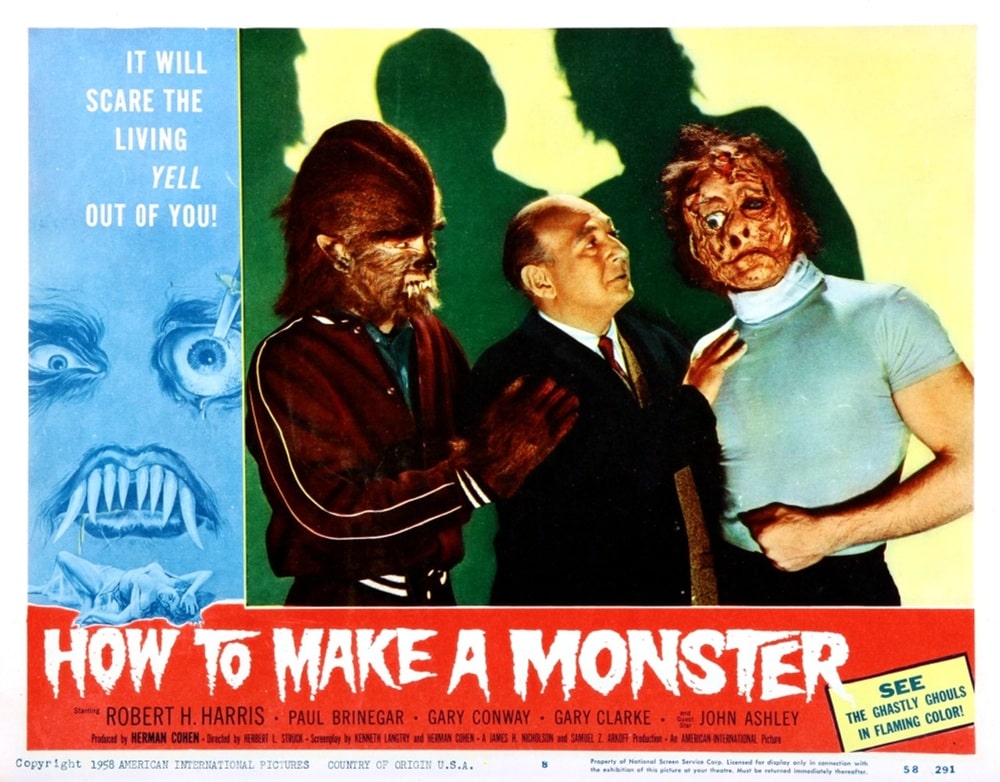 How to Make a Monster ( American International Pictures, July 1, 1958)
How to Make a Monster ( American International Pictures, July 1, 1958)
50 films that I dug up on Tubi.
Enjoy!
How to Make a Monster – 1958, AIPAs a slight deviation from our usual programming of themed lists, here are the results of a deep dive I recently undertook, pushing Tubi to the limits. So here we are with How to make a Monster, a follow-up of sorts to the two spectacular schlock movies, I Was a Teenage Frankenstein and I Was a Teenage Werewolf, both released a year earlier in 1957 from American International Pictures. Monster double-billed with Teenage Caveman (which I previously reviewed when I was on my cave people kick), and is probably my favorite of the film series.
It isn’t your usual narrative, but rather a meta-tale of the studio itself, and I LOVE movies about making movies. In this one, Pete Dumond, the ‘Jack Pierce’ of his day, is the makeup wizard who designed and applied the prosthetics for the two previous films. When he discovers that the studio has been taken over by a company that isn’t interested in monster films, and is subsequently fired, Pete goes on a murderous rampage, only he doesn’t do the killing himself. Instead he brainwashes the young actors playing the monsters via a strange foundation cream (bear with me here) and coerces them to killing the new studio stooges while in full makeup.
Eventually, the cops figure out what is going on, and it all ends up in a rather bonkers and fiery final act. One of the great gimmicks employed here is the final reel being in full colour (a similar stunt was pulled on Teenage Frankenstein), and it’s quite jarring, but in a good way. Fun stuff!
7/10
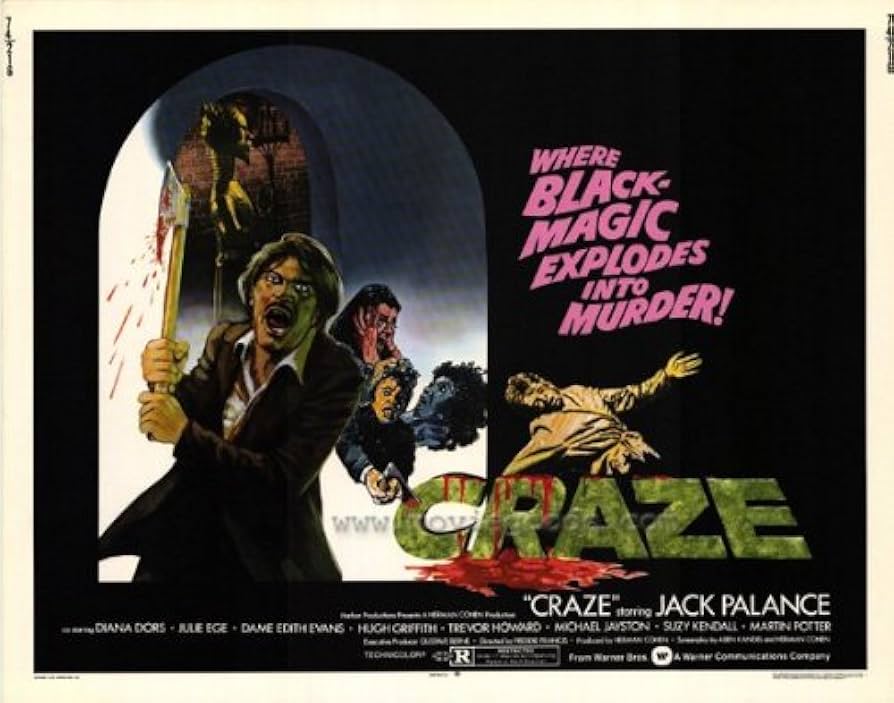 Craze (Warner Bros, June 5, 1974)
Craze (1974)
Craze (Warner Bros, June 5, 1974)
Craze (1974)
A strange little film from one of my favorite directors, Freddie Francis (who hated this one), Craze is based on the novel The Infernal Idol by Henry Seymour. It tells the story of an English antiques dealer who is wrapped up in black magic, and who worships a spooky African idol called Chuku. After a bloody alter, he begins to associate human sacrifices with financial gain (via Chuku), and promptly goes on a murderous spree to keep his idol happy.
Jack Palance is the most unconvincing Englishman ever put on film (until Keanu in Dracula), but he is ably supported by Julie Ege, Diana Dors and Trevor Howard. There are moments that echo the Amicus glory days, however it’s an uneven film, and the version I watched appeared to be edited for ghastliness.
Good if you’re planning a scary idol night.
5/10
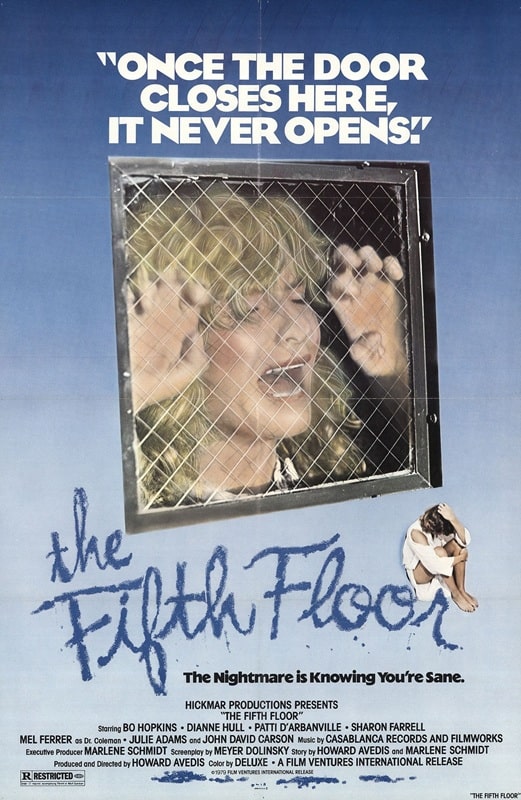

The Fifth Floor (Film Ventures International, November 15, 1978)
and The Boneyard (Zia Film Distribution, June 12, 1991)
Based on a true story, The Fifth Floor is about a young woman, Kelly (played by Diane Hull), who is accidentally poisoned at a disco and is taken to hospital. Her records indicate that she has tried to self harm before at age 15, so she is recommended for psychiatric assessment and care, leading to a three day stay at a facility. She soon runs afoul of a sleazy attendant, and her stay is increased to two-weeks, eventually being drawn out to 60 days. During this time she is abused, both mentally and sexually, and nobody believes her, especially her useless boyfriend.
It’s a pretty run of the mill movie, but the cast is the standout, and makes this an interesting watch. As with One Flew Over the Cuckoo’s Nest, the patients are portrayed by some familiar faces, notably Robert Englund (fresh off telling his roommate to try auditioning for a space movie…), Anthony James (the villain in every TV show and film you ever watched), Earl Boen (who would go on to become a psychiatrist himself in the Terminator films), and Michael Berryman (of course).
The uncaring boss of the facility is played by Mel Ferrer, and the sleazy, abusive orderly is played by none other than Bo Hopkins. Julie Adams plays one of the nurses, so of course this Black Lagoon lover was very happy about that.
Not fun, but I didn’t hate it, which is high praise considering the films I seek out.
5/10
The Boneyard (1991)Here’s an interesting one I hadn’t seen before, and when I say interesting, I mean a bit dull, then utterly barking mad.
Two years before The X-Files gave us Mulder and Scully, The Boneyard gave us Jersey Callum (Ed Nelson) and Alley Oates (Deborah Rose), a detective and psychic respectively, both at the end of their games and leaning against each other for support. A child murder case leads them both to a vast mortuary, run by Phyllis Diller (who totally over-Dillers every scene she’s in). Before you know it the child corpses turn out to be flesh-eating demons, and shenanigans ensue.
Yes, this one is painfully slow to get started, but once it does, it’s a lot of fun. The child demons are quite ghastly and really well made, and it’s a pity the same cannot be said for the two goofy monsters that crop up toward the end. James Cummings was a bit of a makeup legend before he tried his hand at directing, and it showed in the monsters — unfortunately the rest of his direction was really pedestrian.
There are some hilarious moments, some gooey moments, and a poodle moment that would make Ang Lee go off in his pants. Worth a look if you’re feeling brave.
6/10
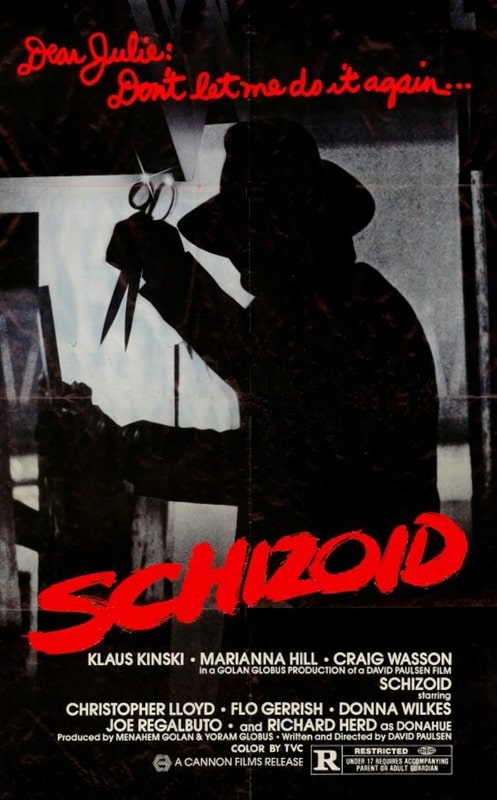
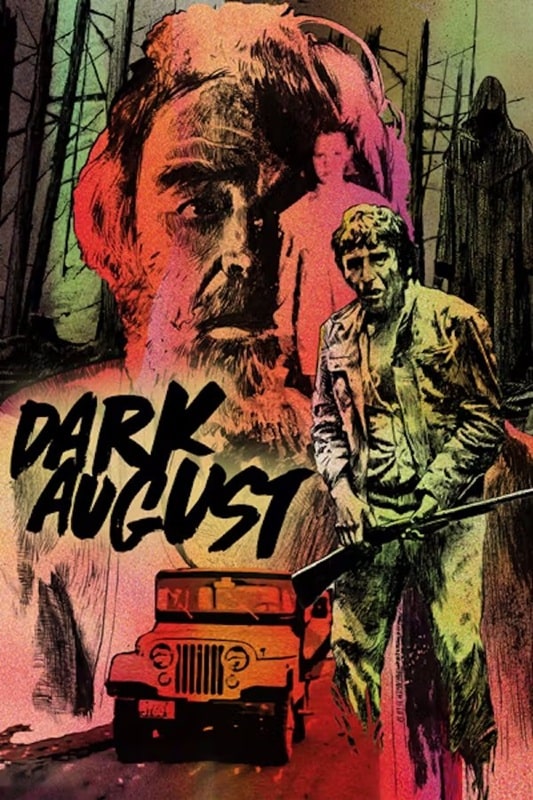
Schizoid (The Cannon Group, September 5, 1980)
and Dark August (Howard Mahler Films, September 10, 1976)
Next up is this non-politically correctly titled slasher from the start of the best decade. Someone is stalking and murdering the members of a therapy group run by the terminally horny Dr. Fales (Kinski).
A newspaper columnist (Marianna Hill) is being sent threatening letters, and the cops (led by Richard Herd) don’t take them seriously. Her creepy ex-husband (Craig Wasson) is more concerned with getting the wallpaper up in his office (!), and Kinski shags everyone.
It’s fine, I guess, except the mystery killer is given away at the beginning. Oh, and Christopher Lloyd is in it, being all weird and sinister, so a bonus point there.
1/10
Dark August (1976)Sal, an artist recently moved from NY to Vermont, doesn’t do a good job of fitting into his new rural life because he immediately runs over a young girl. It’s an accident, but the girl’s spooky grandfather doesn’t see it that way, and proceeds to voodoo Sal up the wazoo.
Creepy apparitions, bloody coughing and tummy aches ensue. It’s a bit slow, but there is a handful of inspired shots. Kim Hunter is in it as a committed medium, so that’s a bonus.
1/10
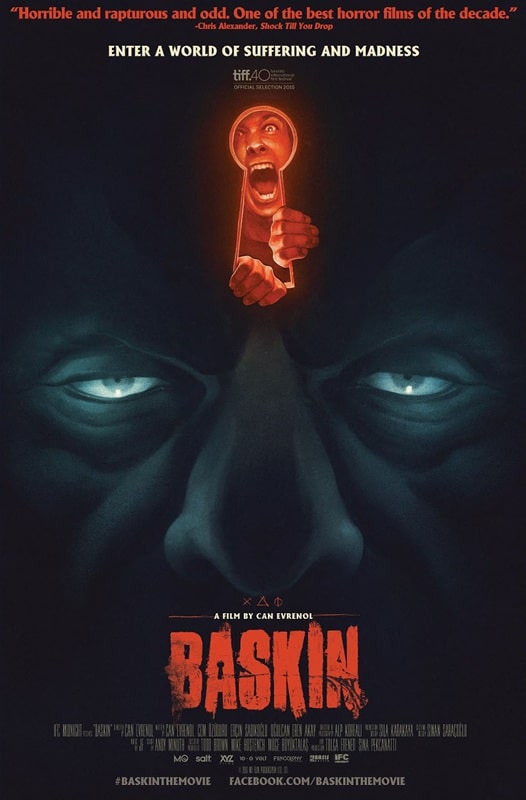 Baskin ()
Baskin (2015, Turkey)
Baskin ()
Baskin (2015, Turkey)
Just five months after the US Thanksgiving celebrations, here is a delicious slice of Turkey, all wrapped up in one hell of a mind-bending horror film.
Baskin is a simple tale about a squad of police officers just mooching about, not doing much, when they get a call to a ‘disturbance’ in a dodgy part of town.
They answer the call, but crash their van along the way and end up at a big old house. The minute they go inside they are confronted by assorted ghastliness, and another officer banging his own head against a wall, and then it all goes rapidly downhill.
They find themselves quite literally in Hell surrounded by writhing masses of flesh and blood, and soon they are in the clutches of a cannibalistic cult, led by an enigmatic and terrifying figure. The sense of dread is astounding, and the film itself is gorgeous, albeit utterly horrific. Its surreal sensibilities put me in mind of Mandy (2018), and its overall sense of doom reminded me of Descent or Dog Soldiers. It’s a bit of a hard watch, and certainly not fun, but it’s worth a watch if you fancy something darker (and stickier) than molasses.
8/10
Previous Murkey Movie surveys from Neil Baker include:
What Possessed You?
Fan of the Cave Bear
There, Wolves
What a Croc
Prehistrionics
Jumping the Shark
Alien Overlords
Biggus Footus
I Like Big Bugs and I Cannot Lie
The Weird, Weird West
Warrior Women Watch-a-thon
Neil Baker’s last article for us was Part III of What Possessed You? Neil spends his days watching dodgy movies, most of them terrible, in the hope that you might be inspired to watch them too. He is often asked why he doesn’t watch ‘proper’ films, and he honestly doesn’t have a good answer. He is an author, illustrator, teacher, and sculptor of turtle exhibits. (AprilMoonBooks.com).
Exhilerating Escape! 6 Mind-Bending Science Fiction & Fantasy Novels
Alright, let’s talk about science fiction novels and fantasy novels, and escape reality for a…
The post Exhilerating Escape! 6 Mind-Bending Science Fiction & Fantasy Novels appeared first on LitStack.
GODKILLER by Hannah Kaner
Tor Doubles #1: Arthur C. Clarke’s Meeting with Medusa and Kim Stanley Robinson’s Green Mars
 Meeting with Medusa cover by Vincent di Fate
Meeting with Medusa cover by Vincent di FateGreen Mars cover by Vincent di Fate
Tor Double #1 was originally published in October 1988. This volume marked the beginning of the official Tor Double series. The two stories included, Arthur C. Clarke’s Meeting with Medusa and Kim Stanley Robinson’s novella Green Mars complement each other, although by doing so, Green Mars also points out a weakness of Meeting with Medusa. The volume was published as a tête-bêche, with both covers were painted by Vincent di Fate.
Meeting with Medusa was originally published in Playboy in December, 1971. It was nominated for the Hugo Award and Nebula Award, winning the latter, as well as the Seiun Award.
The novella opens with Captain Howard Falcon commanding a massive airship, the Queen Elizabeth IV, over the Grand Canyon. A collision with a drone camera causes the ship to crash, killing nearly everyone on-board, including the uplifted chimpanzees who served as part of their crew. Although horribly injured in the crash, Falcon survived and spends years regaining his ability to function, eventually returning to his job as a pilot with an audacious plan.
Falcon proposed a mission to fly through Jupiter’s atmosphere. He notes that many probes have been lost in the atmosphere, but believes that he is uniquely qualified for a crewed mission because he can take evasive action if necessary, noting that he was not at the helm when the Queen Elizabeth IV was struck. His proposal seems like a mix of hubris and a need to atone for the loss of the airship. While Falcon’s reasoning may make sense, the decision to fund and permit him to take on the mission seems a little too pat. However, characterization and motivation has never been Clarke’s forte.
Where Clarke excels, and where Meeting with Medusa succeeds, is building a sense of wonder for the reader. Extrapolating from what was known about Jupiter in the years prior to the first flyby, by Pioneer 10 in 1973, Clarke creates an alien world high in the Jovian atmosphere. Buffeted by hurricane force winds, Falcon provides testimony of the miracles of life that are able to exist there, from the enormous and buoyant medusa, named for the tentacles that dangled beneath them, to the ray-like predators that glide through the skies. The size of these creatures, and the requirements for living where they do, mean that Clarke has incorporated aspects of biology that only exist on a small scale on Earth, if at all.
Gardner Dozois commented that Meeting with Medusa “is a bit traveloguish,” but there is more to the story than simply Falcon’s sightseeing through Jupiter’s skies and achieving a sense of closure for the Queen Elizabeth incident. Clarke provides a more specific reason why Falcon may be the right person for the job, but that final revelation feels a little tacked on and Clarke didn’t make full use of it throughout the story.
Forty-five years after its original publication, authors Stephen Baxter, who collaborated with Clarke, and Alastair Reynolds published a sequel to Meeting with Medusa, the novel The Medusa Chronicles, which expanded on the world Clarke described and the character who explored that world.
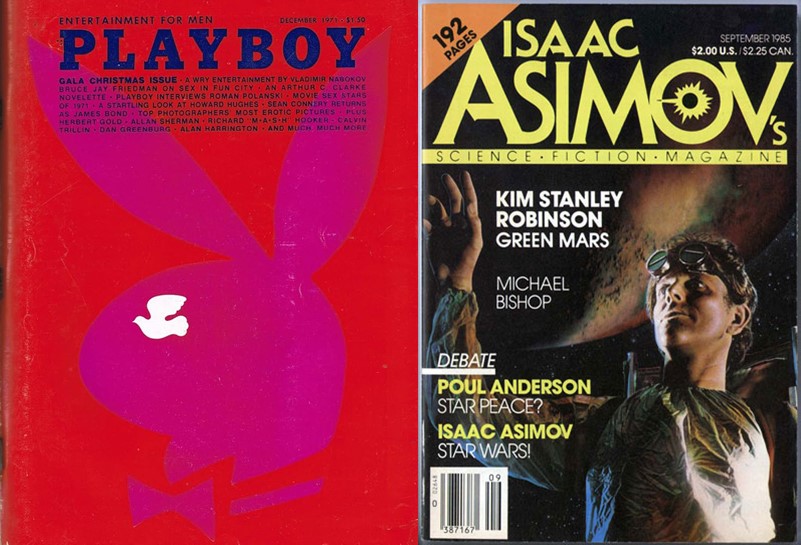 Playboy cover by an unknown artist
Playboy cover by an unknown artistAsimov’s Science Fiction Magazine, September 1985, cover by J.K. Potter
The novella Green Mars was originally published in Isaac Asimov’s Science Fiction Magazine in September, 1985 and should not be confused with Robinson’s 1993 novel Green Mars. It was nominated for the Hugo Award and the Nebula Award.
Roger Clayborne, who is around 300 years old, has resigned from his position as Minister of the Interior for Mars, a position he has held for 27 years. A member of the Red Party, which championed the maintenance of Mars in its natural state, he has come to realize that his ideology has lost out to the Greens, who have successfully terraformed Mars to an extent that conserving its pristine nature is no longer possible.
In his own attempt to get back to nature, Clayborne signs on with an expedition to climb Olympus Mons, at 22 kilometers, the tallest mountain in the solar system, with a peak that juts out of the planet’s atmosphere. All expert climbers, including a woman Clayborne knew more than 250 years earlier, the trek up the mountain proves dangerous, between the threat of rockfall, weather, and the thinner Martian atmosphere.
Set over the span of several weeks, Clayborne interacts with nearly all of the other members of the expedition in various ways and the expedition leader, Eileen Monday, makes sure to rotate who partners with whom. With a cast of eleven characters, some do get short shrift (only one of the four “Sherpas” is given a last name and none of them are fleshed out), but Robinson does limn out distinctions between most of the characters, from Marie Whillans’ exuberance to Dougal Burke’s quiet competence. Roger’s interactions often depict part of the story, but Robinson makes clear that there are complex relationships behind the scenes.
Robinson also describes the climb in details, introducing the reader to a variety of concepts used to scale mountains and showing that, even with the relatively gentle slope of Olympus Mons, the ascent is difficult, with a lot of climbing and descending as paths and dead ends are discovered and materials are carefully positioned to ensure the expedition’s chance of success. At the same time, injuries happen and must be dealt with, not always in the most obvious ways.
As Clayborne climbs the mountain, the natural beauty and his discussions with the other climbers slowly begins to make him reconsider what it means to be a Red in a world in which terraforming has already taken hold. By the time he reaches the summit, he comes to a conclusion that he can still work to preserve Mars under what he considers to be less than ideal circumstances, but also understands that a terraformed Mars as a beauty all its own.
Both stories are explorations of strange vistas, with Clarke exploring the atmosphere of Jupiter and raising perceptual questions about both the concept of landscapes and life, introducing cloudbanks that were seen as mountains and massive creatures that lived in the atmosphere, never landing. Robinson presented the different layers of Olympus Mons, drawing parallels between mountains and rock formations on Earth with those on Mars as his climbers made the dangerous ascent. However, while both are explorations into the unknown, Robinson also focused on the relationships between the members of his climbing expedition, while Clarke’s protagonist spends most of the story is solitude. The result of this is that the strength of Robinson’s characters highlights the weakness of Clarke’s characters.
 Steven H Silver is a twenty-time Hugo Award nominee and was the publisher of the Hugo-nominated fanzine Argentus as well as the editor and publisher of ISFiC Press for eight years. He has also edited books for DAW, NESFA Press, and ZNB. His most recent anthology is Alternate Peace and his novel After Hastings was published in 2020. Steven has chaired the first Midwest Construction, Windycon three times, and the SFWA Nebula Conference numerous times. He was programming chair for Chicon 2000 and Vice Chair of Chicon 7.
Steven H Silver is a twenty-time Hugo Award nominee and was the publisher of the Hugo-nominated fanzine Argentus as well as the editor and publisher of ISFiC Press for eight years. He has also edited books for DAW, NESFA Press, and ZNB. His most recent anthology is Alternate Peace and his novel After Hastings was published in 2020. Steven has chaired the first Midwest Construction, Windycon three times, and the SFWA Nebula Conference numerous times. He was programming chair for Chicon 2000 and Vice Chair of Chicon 7.


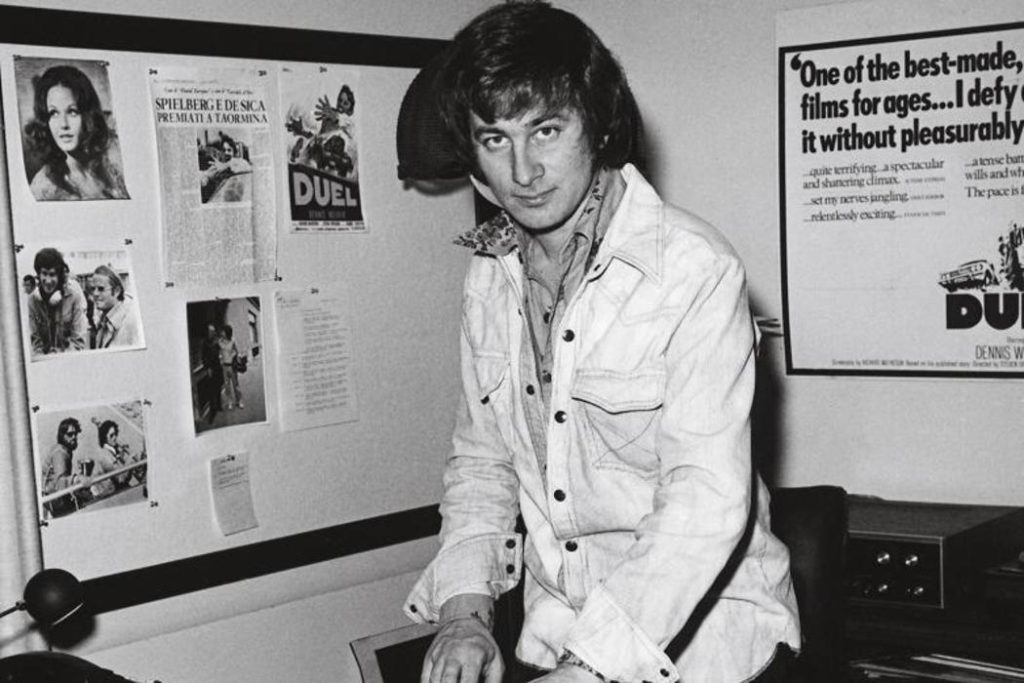



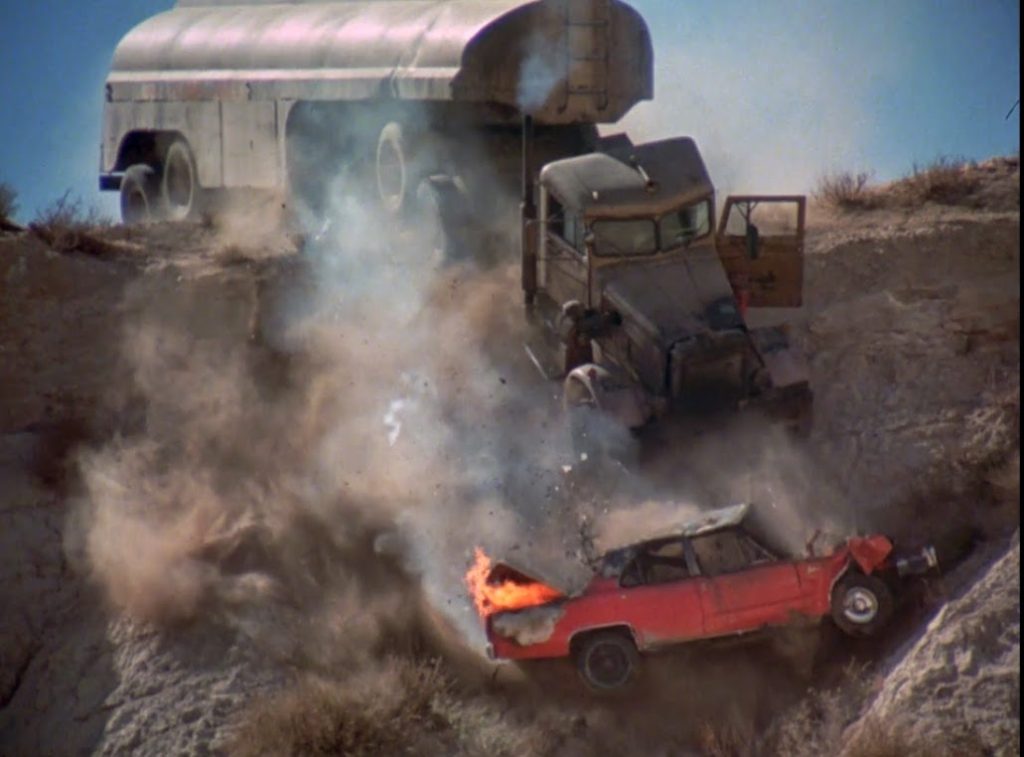

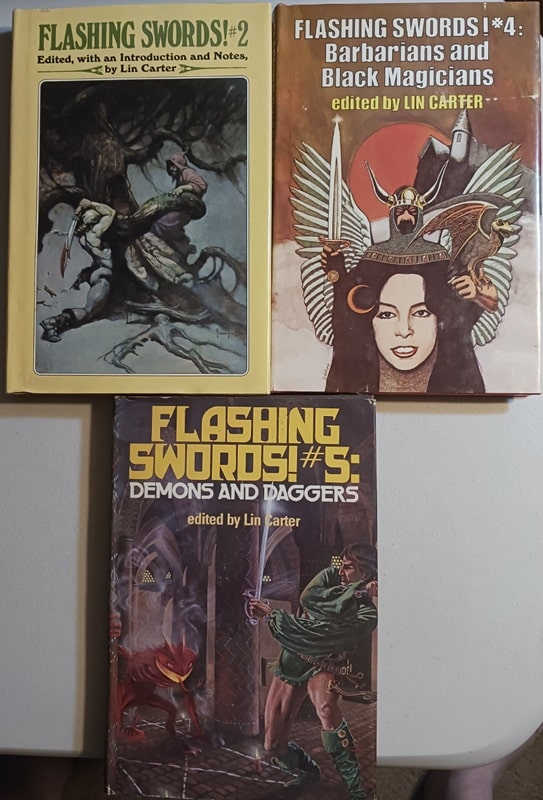
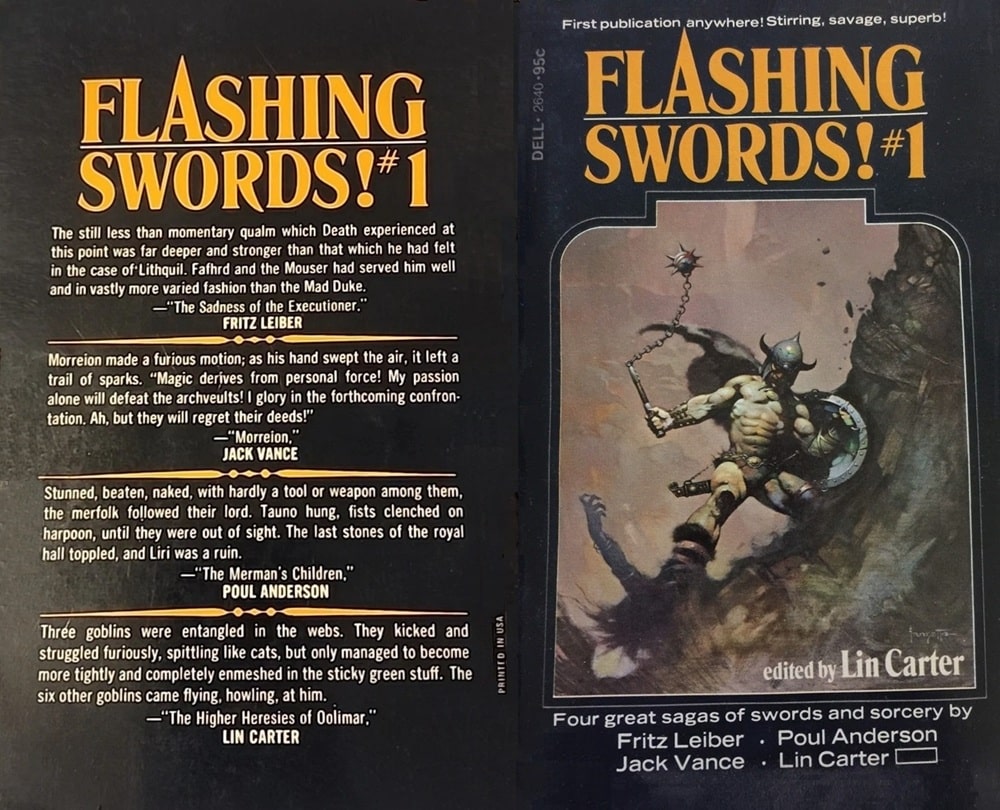
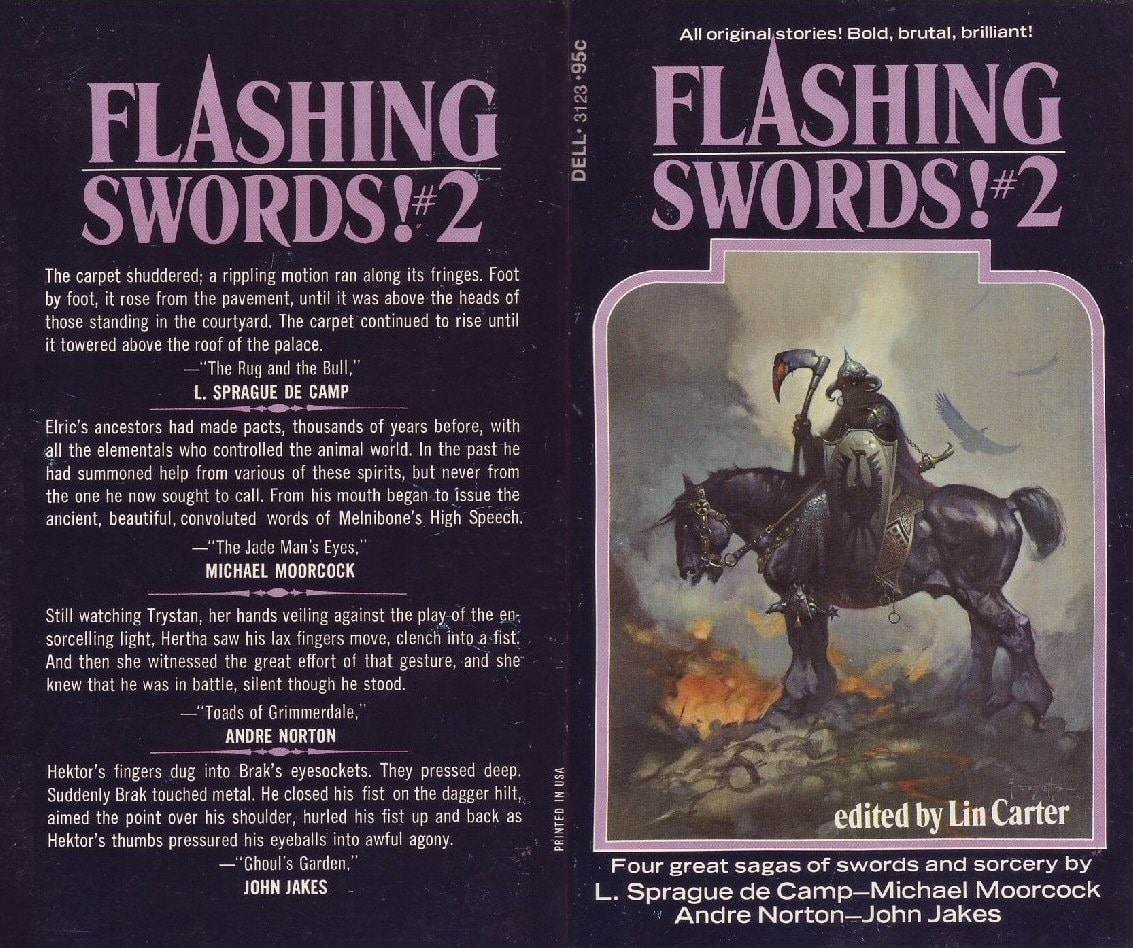
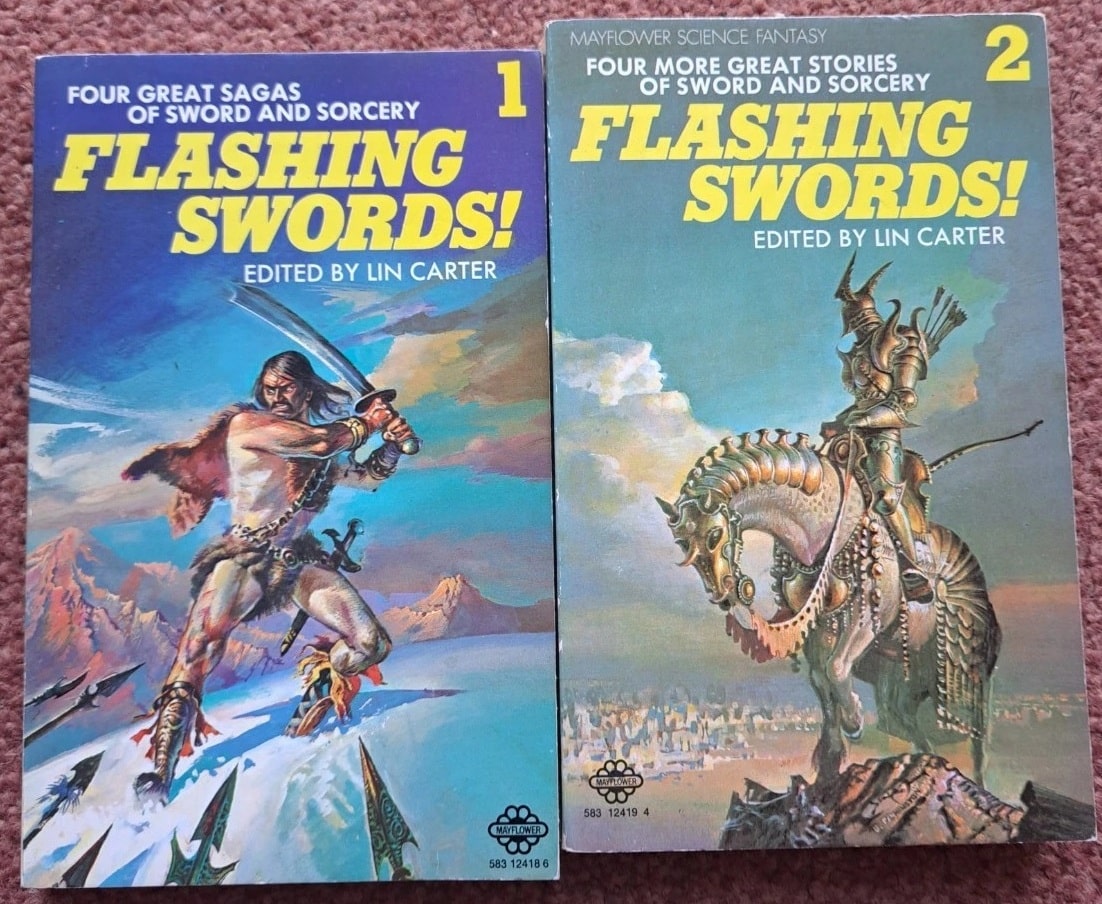
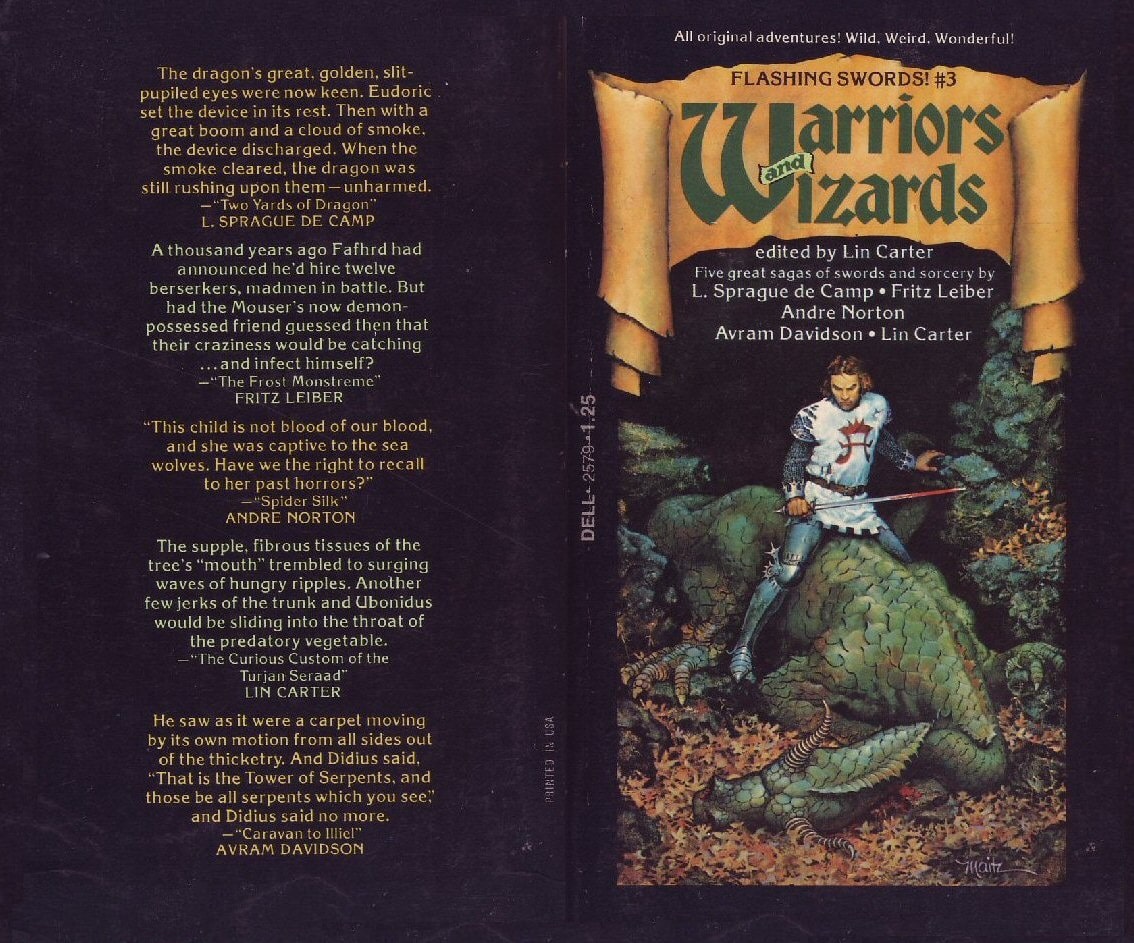
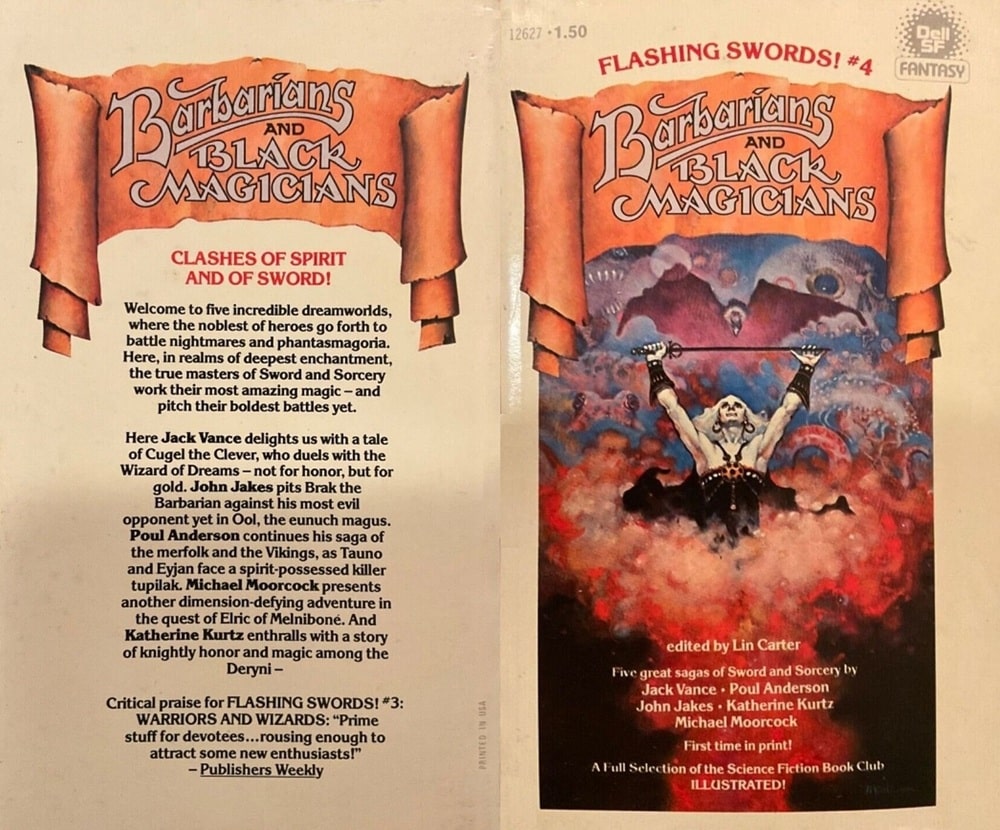
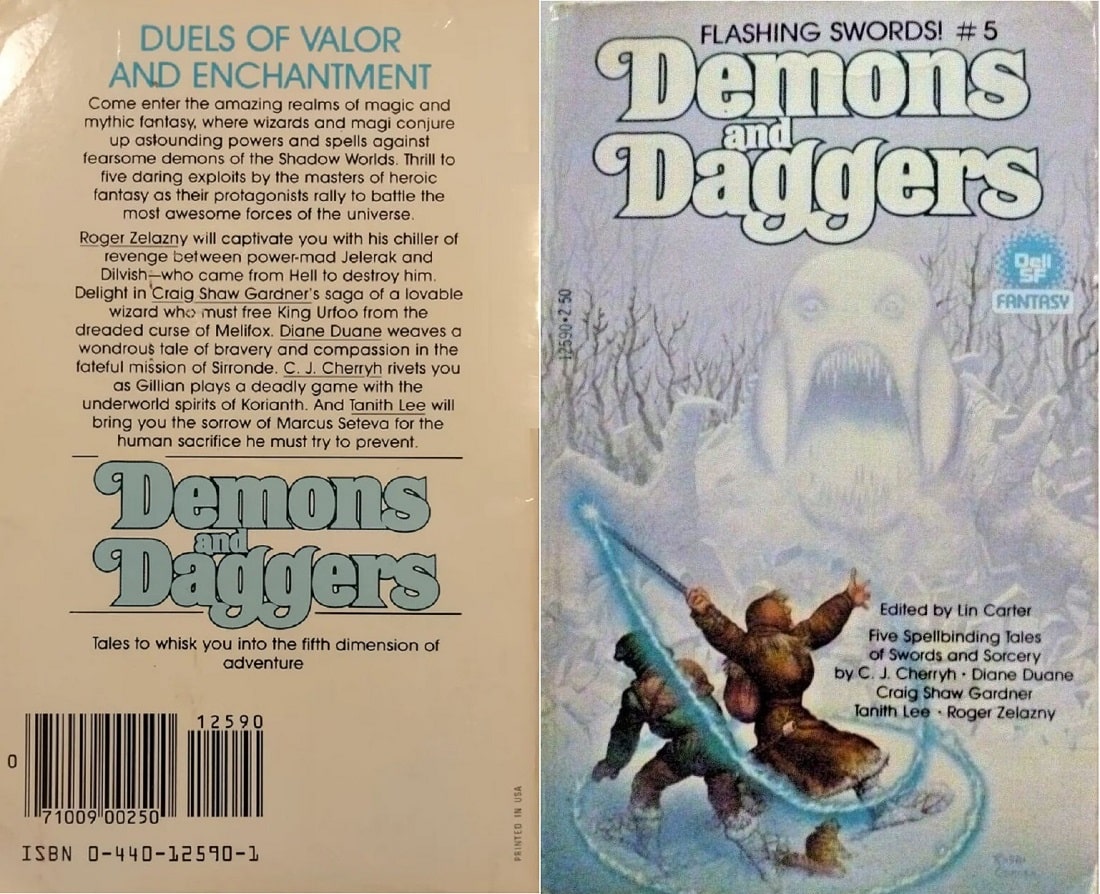

Recent comments